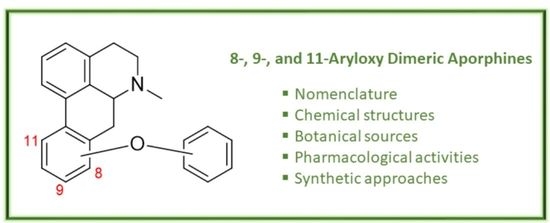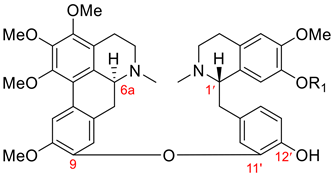8-, 9-, and 11-Aryloxy Dimeric Aporphines and Their Pharmacological Activities
Abstract
1. Introduction
- (1)
- Carbon–carbon bonded dimers, where the two aporphinoid units are coupled by a C–C bond. They include:
- i.
- Bisaporphines: the two aporphine units form either 7,7′-, 7,4′-, or 8,8′- linked dimers.
- ii.
- Aporphine–benzylisoquinoline dimers (uskudaramine type): these compounds have a C–C bond between C8 of the aporphine unit and C11’ of the benzylisoquinoline moiety.
- (2)
- Ether-bonded dimers, where the two halves of the dimer are connected by an ether linkage. They include:
- i.
- Bisaporphines: the two aporphine units are linked together by an ether bond that may be formed between C1 and C2’, C8 and C9’, or C8 and C11’.
- ii.
- Proaporphine–benzylisoquinoline dimers: this group includes pakistanamine- and epivaldiberine-type dimers. The ether bond is located between C9 of the proaporphine moiety and C12’ of the benzylisoquinoline unit in the case of pakistanamine-type dimers. However, it is located between C11 of the proaporphine unit and C12’ of the benzylisoquinoline moiety in epivaldiberine-type dimers.
- iii.
- Aporphine–phenyl (hernandaline-type) and proaporphine–phenyl (coyhaiquine-type) dimers: hernandaline-type dimers have a substituted phenyl ether linked to an aporphine moiety at C9. Additionally, the phenyl group can be connected to the aporphine unit at C1 or C8. On the other hand, coyhaiquine-type dimers possess a substituted phenyl ether connected to C9 of a proaporphine unit. These two rare subgroups are probably formed via the oxidation of the benzylisoquinoline half of the dimer into hydroxyl methyl, aldehyde, carboxylic acid, or ester-substituted phenyl ethers.
- iv.
- Aporphine–protoberberine dimers: the protoberberine unit is coupled to the aporphine moiety at either C8 or C9.
- v.
- Aporphine–pavine dimers: the pavine unit is connected to the aporphine moiety at C9.
- vi.
- Aporphine–benzylisoquinoline dimers: this is the largest subgroup of dimeric aporphines. Based on the nature of the tetrahydroisoquinoline moiety (S-reticuline or S-coclaurine), from which each monomer can be derived, and the location of the ether linkage between the two halves of the dimer, aporphine–benzylisoquinoline dimeric alkaloids can be divided into: (1) reticuline–reticuline dimers (thalicarpine and fetidine types), (2) reticuline–coclaurine dimers (istanbulamine and thalifaberine types), and (3) coclaurine–coclaurine dimers (pakistanine and kalashine types). Table 1 illustrates the position of the ether bond in each type.
2. C8-Aryloxy Aporphines and 6a,7-Dehydroaporphines
2.1. Chemical Structure Classification and Occurrence
- (1)
- Bisaporphines: only two isolated bisaporphines (Figure 2) with an ether linkage at C8 of one of the aporphine units have been reported. They were isolated in 1996 from the leaves of Dehaasia triandra. The first bisaporphine, named dehatriphine (3), has an ether linkage at the C8’ position of isocorydine and the C9 position of N-methyl-laurotetanine [26], while the second compound, named (11,8′)-O-bisisocorydine (4), has two isocorydine units connected by an ether bond at C8’ and C11 of the two units [27].
- (2)
- (3)
- Aporphine and 6a,7-dehydroaporphine–phenyl dimeric alkaloids: thaliculine (6) and 6a,7-dehydrothaliculine (7), shown in Figure 3, represent the only reported examples to date with an ether bond at C8 of the aporphine unit. They were isolated together in 2019 from the roots of Thalictrum cultratum [29].
- (4)
- Aporphine and 6a,7-dehydroaporphine–benzylisoquinoline dimers: this is the largest group of C8-aryloxy aporphines. To date, thirty-three members belonging to this group have been reported. The names, chemical structures, and botanical sources of these compounds are shown in Table 2, Table 3, Table 4 and Table 5.
2.2. Biological Activities of C8-Aryloxy Aporphines and 6a,7-Dehydroaporphines
2.3. Reported Synthetic Approaches for C8-Aryloxy Aporphines
3. C9-Aryloxy Aporphines and 6a,7-Dehydroaporphines
3.1. Chemical Structure Classification and Occurrence
- (1)
- (2)
- Aporphine–protoberberine dimeric alkaloids: the first member of this group, (−)-thalibealine (56) (Figure 5), was isolated in 2001 from the roots of Thalictrum wangiii Boivin. [52] and later from the roots of Thalictrum cultratum [42]. Additionally, corydaturtschine B (57) and (−)-thalicultratine L (58) (shown in Figure 5) were isolated from Corydalis turtschaninovii Bess. [53] and Thalictrum cultratum [42], respectively.
- (3)
- Aporphine and 6a,7-dehydroaporphine–phenyl dimeric alkaloids (hernandaline type): Table 6 shows the names, chemical structures, and botanical sources of seven aporphine–benzyl dimers. Additionally, the structure of 6a,7-dehydrohernandaline (59) isolated from Hernandia sonora [54] is depicted in Figure 6.
- (4)
- Aporphine and 6a,7-dehydroaporphine–benzylisoquinoline dimeric alkaloids: this is the largest group of C9-aryloxy aporphines and contains fifty reported compounds to date. The names, chemical structures, and botanical sources of these compounds are shown in Table 7, Table 8, Table 9, Table 10, Table 11, Table 12 and Table 13 and Figure 7, Figure 8, Figure 9 and Figure 10. These compounds can be organized, as mentioned in Section 1 (Table 1), according to the location of the ether bond and the substitution pattern on the benzyltetrahydroisoquinoline moiety into four groups; thalicarpine, fetidine, istanbulamine, and pakistanine. Additionally, some compounds do not belong to any of the abovementioned types and constitute a new type of aporphine–benzylisoquinoline dimers linked at C9 of the aporphine unit.
3.1.1. Thalicarpine-Type Dimers

| Name | R1 | R2 | R3 | R4 | R5 | R6 | R7 | Botanical Source |
|---|---|---|---|---|---|---|---|---|
| (+)-thalicarpine (43) (structure revision [65]) | Me | H | H | OMe | OMe | Me | Me | Thalictrum dasycarpum Fisch. And Lall. [64] Thalictrum minus var. elatum Jacq. [66] Thalictrum revolutum [67] Hernandia ovigera L. [65,68,69,70] Thalictrum minus L. ssp. elatum [71] Thalictrum flavum L. [72] Thalictrum polygamum [73] Thalictrum revolutum DC [74,75,76] Thalictrum dioicum L. [77,78] Thalictrum minus L. [79,80] Thalictrum alpinum L. [81] Thalictrum foliolosum DC [82,83] Hernandia nymphaeifolia [56,57] |
| (+)-thalmelatine (67) (structure revision [65]) | Me | H | H | OMe | OH | Me | Me | Thalictrum minus var. elatum Jacq. [66] Thalictrum minus L. ssp. elatum [71] Thalictrum revolutum DC. [74,75,76] Thalictrum dioicum L. [78] Thalictrum minus L. [80] Thalictrum foetidum L. [84] Thalictrum minus L. subsp. minus [41] |
| (+)-adiantifoline (68) | Me | OMe | H | OMe | OMe | Me | Me | Thalictrum minus L. var. adiantifolium Hort. [85,86,87] Thalictrum minus L. ssp. elatum [88] Thalictrum minus L., race B. [89] Thalictrum minus var. microphyllum [90] Thalictrum cultratum [33] Thalictrum minus var. minus L. [91] Thalictrum minus L. var. majus [92] Thalictrum honanense W. T. Wang [93] |
| (+)-O-desmethyladiantifoline (69) | Me | OMe | H | OH | OMe | Me | Me | Thalictrum minus L. ssp. elatum [88] |
| (+)-thalmelatidine (70) (structure revision [94]) | Me | OMe | OCH2O | OMe | Me | Me | Thalictrum minus L. ssp. elatum [88,95] Thalictrum minus var. microphyllum [90] Thalictrum cultratum [33] Thalictrum minus var. minus L. [91] Thalictrum minus var. hypoleucum [96] Thalictrum minus L. var. majus [92] Thalictrum honanense W. T. Wang et S. H. Wang [93] | |
| (+)-thalmineline (71) | Me | OMe | OH | OMe | OMe | Me | Me | Thalictrum minus L. var. elatum Koch. [97,98] Thalictrum cultratum [33] Thalictrum minus var. minus L. [91] |
| (+)-thalictropine (72) | H | H | H | OMe | OMe | Me | Me | Thalictrum polygamum [99] Thalictrum dioicum L. [78] |
| (+)-thalictrogamine (73) | H | H | H | OMe | OH | Me | Me | Thalictrum polygamum [99] Thalictrum revolutum DC. [100] Thalictrum dioicum L. [78] Thalictrum foetidum L. [84] |
| (+)-thalidoxine (74) | Me | H | H | OMe | OMe | Me | H | Thalictrum dioicum L. [101] |
| (+)-pennsylvanine (75) | Me | H | H | OMe | OMe | H | Me | Thalictrum polygamum Muhl. [102] Thalictrum revolutum DC. [75,100] Thalictrum dioicum L. [78] |
| (+)-pennsylvanamine (76) | H | H | H | OMe | OMe | H | Me | Thalictrum polygamum Muhl. [102] Thalictrum foetidum L. [103] |
| (+)-thalipine (77) | Me | H | H | OMe | OH | H | Me | Thalictrum polygamum Muhl. [104] Thalictrum revolutum DC. [76,100,105] Thalictrum minus L. [80] Thalictrum foetidum L. [84] |
| (+)-thalilutidine (78) | Me | H | H | OH | OMe | Me | Me | Thalictrum revolutum DC. [106] |
| (+)-thalilutine (79) | Me | OH | H | OMe | OMe | Me | Me | Thalictrum revolutum DC. [106] Thalictrum cultratum [33] |
| (+)-thaliadanine (80) | Me | OMe | H | OMe | OH | Me | Me | Thalictrum minus L., race B. [58] Thalictrum minus var. microphyllum [90] |
| (+)-bursanine (81) | Me | OMe | H | OMe | OH | H | Me | Thalictrum minus var. microphyllum Boiss. [107] |
| (+)-methoxyadiantifoline (82) | Me | OMe | OMe | OMe | OMe | Me | Me | Thalictrum omeiense W.T. Wang [108] Thalictrum foetidum L. [109] |
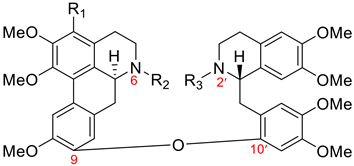
| Name | R1 | R2 | R3 | Botanical Source |
|---|---|---|---|---|
| (+)-2′-northalicarpine (83) | H | Me | H | Thalictrum revolutum DC. [111] |
| (+)-2′-noradiantifoline (84) | OMe | Me | H | Thalictrum minus L. var. microphyllum Boiss. [112] |
| (+)-6-northalicarpine (85) | H | H | Me | Hernandia peltate [110] |
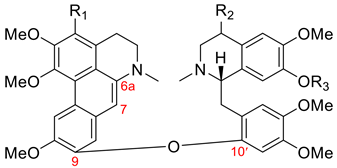
| Name | R1 | R2 | R3 | Botanical Source |
|---|---|---|---|---|
| 6a,7-dehydrothalicarpine (87) | H | H | Me | Thalictrum minus L. ssp. elatum [113] Thalictrum dasycarpum Fisch. And Lall. [114] Hernandia ovigera L. [70] |
| 6a,7-dehydrothalmelatine (88) | H | H | H | Hernandia peltate [110] Thalictrum minus L. subsp. minus [41] |
| (+)-6a,7-dehydromethoxyadiantifoline (89) | OMe | OMe | Me | Thalictrum foetidum L. [109] |
3.1.2. Fetidine-Type Dimers
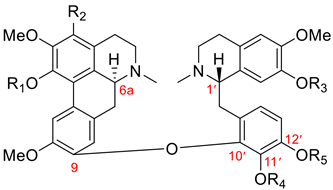
| Name | R1 | R2 | R3 | R4 | R5 | Botanical Source |
|---|---|---|---|---|---|---|
| (+)-fetidine (90) (structure revision [116]) | H | H | Me | Me | Me | Thalictrum foetidum [115,117,118] |
| (+)-revolutopine (91) (structure revision [25]) | Me | H | H | H | Me | Thalictrum revolutum DC. [100,105] |
| (+)-thalirevoline (92) | Me | H | Me | Me | H | Thalictrum revolutum DC. [100,106] |
| (+)-thalirevolutine (93) | Me | H | Me | Me | Me | Thalictrum revolutum DC. [106] |
| (+)-iznikine (94) | Me | OMe | H | H | Me | Thalictrum minus var. microphyllum Boiss. [107] |
| (+)-huangshanine (95) | Me | OMe | Me | Me | Me | Thalictrum faberi Ulber [30] |
| (+)-faberidine (96) | Me | H | H | Me | Me | Thalictrum faberi Ulber [31] |
| (+)-faberonine (97) | Me | OMe | H | Me | Me | Thalictrum faberi Ulber [31] |
3.1.3. Istanbulamine-Type Dimers
3.1.4. Pakistanine-Type Dimers
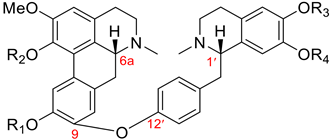
| Name | R1 | R2 | R3 | R4 | Botanical Source |
|---|---|---|---|---|---|
| (+)-pakistanine (101) | H | H | Me | Me | Berberis baluchistanica Ahrendt [120,121] Berberis calliobotrys Bienert ex Aitch. [122] Berberis orthobotrys Bienert ex Aitch. [123,124,125] Berberis empetrifolia Lam. [62,126,127] Berberis waziristanica [128] Berberis sibirica [129] Berberis aristata [130] |
| (+)-1-O-methylpakistanine (102) | H | Me | Me | Me | Berberis orthobotrys Bienert ex Aitch. [124,125] Berberis calliobotrys Bienert ex Aitch. [122] Berberis aristata [130] |
| (+)-chitraline (103) | H | H | Me | H | Berberis orthobotrys Bienert ex Aitch. [124,125] Berberis zabeliana Schneider [122] Berberis calliobotrys Bienert ex Aitch. [122] |
| (+)-porveniramine (104) | H | H | H | Me | Berberis empetrifolia Lam. [131] |
| (+)-1-O-methylchitraline (105) | H | Me | Me | H | Berberis darwinii Hook [119] |
| (+)-waziristanine (106) | H | Me | H | Me | Berberis waziristanica [128] |
| 1,10-di-O-methylpakistanine (107) | Me | Me | Me | Me | Berberis sibirica Pall. [132] |
3.1.5. New Type of Aporphine–Benzylisoquinoline Dimers

| Name | R1 | R2 | R3 | R4 | Botanical Source |
|---|---|---|---|---|---|
| (+)-przewalskine (109) | OCH2O | OMe | H | Thalictrum przewaliskii [133] Tabernaemontana bufalina Lour. [134] | |
| (+)-przewalskinine (110) | OCH2O | H | OMe | Thalictrum przewaliskii [133] | |
| (+)-przewalstine (111) | H | OMe | OMe | H | Thalictrum przewaliskii [133] |
| (+)-przewalstinine (112) | H | OMe | H | OMe | Thalictrum przewaliskii [133] |
| (+)-przewalstidine (113) | OH | OMe | OMe | H | Thalictrum przewaliskii [133] |
| (+)-przewalstidinine (114) | OH | OMe | H | OMe | Thalictrum przewaliskii [133] |
3.2. Biological Activities of C9-Aryloxy Aporphines and 6a,7-Dehydroaporphines
3.3. Reported Synthetic Approaches for C9-Aryloxy Aporphines
4. C11-Aryloxy Aporphines (Kalashine Type)
4.1. Chemical Structure Classification and Occurrence
4.2. Reported Synthetic Approaches for C11-Aryloxy Aporphines
5. Summary
Author Contributions
Funding
Data Availability Statement
Conflicts of Interest
Sample Availability
References
- Guinaudeau, H.; Leboeuf, M.; Cave, A. Aporphine alkaloids. Lloydia 1975, 38, 275–338. [Google Scholar]
- Guinaudeau, H.; Leboeuf, M.; Cavé, A. Aporphine alkaloids. II. J. Nat. Prod. 1979, 42, 325–360. [Google Scholar] [CrossRef]
- Guinaudeau, H.; Leboeuf, M.; Cavé, A. Aporphinoid alkaloids, III. J. Nat. Prod. 1983, 46, 761–835. [Google Scholar] [CrossRef]
- Guinaudeau, H.; Leboeuf, M.; Cavé, A. Aporphinoid alkaloids, IV. J. Nat. Prod. 1988, 51, 389–474. [Google Scholar] [CrossRef]
- Guinaudeau, H.; Lebœuf, M.; Cavé, A. Aporphinoid alkaloids, V. J. Nat. Prod. 1994, 57, 1033–1135. [Google Scholar] [CrossRef]
- Ríos, J.L.; Máñez, S.; Giner, R.M.; Recio, M.C. Chapter 2—Biological aspects of aporphinoid alkaloids. In The Alkaloids: Chemistry and Biology; Cordell, G.A., Ed.; Academic Press: San Diego, CA, USA, 1999; pp. 57–117. [Google Scholar]
- Chen, J.; Gao, K.; Liu, T.; Zhao, H.; Wang, J.; Wu, H.; Liu, B.; Wang, W. Aporphine alkaloids: A kind of alkaloids’ extract source, chemical constitution and pharmacological actions in different botany: A review. Asian J. Chem. 2013, 25, 10015–10027. [Google Scholar] [CrossRef]
- Nabavi, S.M.; Uriarte, E.; Fontenla, J.A.; Rastrelli, L.; Sobarzo-Sanchez, E. Aporphine alkaloids and their antioxidant medical application: From antineoplastic agents to motor dysfunction diseases. Curr. Org. Chem. 2017, 21, 342–347. [Google Scholar] [CrossRef]
- Stevigny, C.; Bailly, C.; Quetin-Leclercq, J. Cytotoxic and antitumor potentialities of aporphinoid alkaloids. Curr. Med. Chem. Anti-Cancer Agents 2005, 5, 173–182. [Google Scholar] [CrossRef]
- Liu, Y.; Liu, J.; Di, D.; Li, M.; Fen, Y. Structural and mechanistic bases of the anticancer activity of natural aporphinoid alkaloids. Curr. Top. Med. Chem. 2013, 13, 2116–2126. [Google Scholar] [CrossRef]
- Qing, Z.-X.; Huang, J.-L.; Yang, X.-Y.; Liu, J.-H.; Cao, H.-L.; Xiang, F.; Cheng, P.; Zeng, J.-G. Anticancer and reversing multidrug resistance activities of natural isoquinoline alkaloids and their structure-activity relationship. Curr. Med. Chem. 2018, 25, 5088–5114. [Google Scholar] [CrossRef]
- Rodríguez-Arce, E.; Cancino, P.; Arias-Calderón, M.; Silva-Matus, P.; Saldías, M.; Epifano, F. Oxoisoaporphines and aporphines: Versatile molecules with anticancer effects. Molecules 2020, 25, 108. [Google Scholar] [CrossRef]
- Qing, Z.-X.; Yang, P.; Tang, Q.; Cheng, P.; Liu, Y.; Zheng, Y.-j.; Liu, Y.-S.; Zeng, J.-G. Isoquinoline alkaloids and their antiviral, antibacterial, and antifungal activities and structure-activity relationship. Curr. Org. Chem. 2017, 21, 1–15. [Google Scholar] [CrossRef]
- Neumeyer, J.L.; Baldessarini, R.J.; Arana, G.W.; Campbell, A. Aporphines as dopamine receptor agonists and antagonists at central dopamine receptors. New Methods Drug Res. 1985, 1, 153–166. [Google Scholar]
- Zhang, A.; Zhang, Y.; Branfman, A.R.; Baldessarini, R.J.; Neumeyer, J.L. Advances in development of dopaminergic aporphinoids. J. Med. Chem. 2007, 50, 171–181. [Google Scholar] [CrossRef]
- Cassels, B.K.; Asencio, M. Monoaminergic, ion channel and enzyme inhibitory activities of natural aporphines, their analogues and derivatives. Nat. Prod. Commun. 2008, 3, 643–653. [Google Scholar] [CrossRef]
- O’Brien, P.; Carrasco-Pozo, C.; Speisky, H. Boldine and its antioxidant or health-promoting properties. Chem. Biol. Interact. 2006, 159, 1–17. [Google Scholar] [CrossRef]
- Muthna, D.; Cmielova, J.; Tomsik, P.; Rezacova, M. Boldine and related aporphines: From antioxidant to antiproliferative properties. Nat. Prod. Commun. 2013, 8, 1797–1800. [Google Scholar] [CrossRef]
- Zhang, A.; Neumeyer, J.L.; Baldessarini, R.J. Recent progress in development of dopamine receptor subtype-selective agents: Potential therapeutics for neurological and psychiatric disorders. Chem. Rev. 2007, 107, 274–302. [Google Scholar] [CrossRef]
- Ribaric, S. The pharmacological properties and therapeutic use of apomorphine. Molecules 2012, 17, 5289–5309. [Google Scholar] [CrossRef]
- Nabavi, S.F.; Uriarte, E.; Rastrelli, L.; Modak, B.; Sobarzo-Sanchez, E. Aporphines and parkinson’s disease: Medical tools for the future. Curr. Top. Med. Chem. 2016, 16, 1906–1909. [Google Scholar] [CrossRef]
- Nabavi, S.M.; Uriarte, E.; Rastrelli, L.; Sobarzo-Sanchez, E. Aporphines and Alzheimer’s disease: Towards a medical approach facing the future. Curr. Med. Chem. 2019, 26, 3253–3259. [Google Scholar] [CrossRef]
- Guinaudeau, H.; Leboeuf, M.; Cavé, A. Dimeric aporphine-benzylisoquinoline and aporphine-pavine alkaloids. J. Nat. Prod. 1979, 42, 133–149. [Google Scholar] [CrossRef]
- Guinaudeau, H.; Leboeuf, M.; Cavé, A. Dimeric aporphinoid alkaloids, II. J. Nat. Prod. 1984, 47, 565–580. [Google Scholar] [CrossRef]
- Guinaudeau, H.; Leboeuf, M.; Cavé, A. Dimeric aporphinoid, alkaloids, III. J. Nat. Prod. 1988, 51, 1025–1053. [Google Scholar] [CrossRef]
- Lee, S.-S.; Chen, C.-K.; Chen, I.-S.; Chen, C.-H. Chemical constituents from Dehaasia triandra. I. Three new alkaloids, isocorydione, norisocorydione, and dehatriphine, from the leaves. J. Nat. Prod. 1996, 59, 55–58. [Google Scholar] [CrossRef]
- Lee, S.-S.; Chen, C.-K.; Chen, C.-H. Chemical constituents from Dehaasia triandra. II. Five new alkaloids, secoxanthoplanine, dehydroisocorydione, 11,8′-o-bisisocorydine, (8,8′-R)- and (8,8′-S)- bisisocorydine, isolated from the leaves. Tetrahedron 1996, 52, 6561–6568. [Google Scholar]
- Lin, C.-W.; Su, J.-Y.; Zeng, L.-M.; Li, H.; Peng, W.-L.; Xu, A.-L. Structure determination of a new ether-linkage bisalkaloid acutiaporberine. Gaodeng Xuexiao Huaxue Xuebao 2000, 21, 1820–1823. [Google Scholar]
- Kang, W.; Li, J.; Li, D.; Li, Z.; Chen, S.; Hua, H.; Bai, J. New benzyl-aporphine alkaloids from Thalictrum cultratum. Nat. Prod. Res. 2019, 33, 3176–3179. [Google Scholar] [CrossRef] [PubMed]
- Lin, L.Z.; Wagner, H.; Seligmann, O. Thalifaberine, thalifabine and huangshanine, three new dimeric aporphine-benzylisoquinoline alkaloids. Planta Med. 1983, 49, 55–56. [Google Scholar] [CrossRef]
- Wagner, H.; Lin, L.Z.; Seligmann, O. New dimeric aporphine-benzylisoquinoline alkaloids from Thalictrum faberi. Tetrahedron 1984, 40, 2133–2139. [Google Scholar] [CrossRef]
- Hussain, S.F.; Freyer, A.J.; Guinaudeau, H.; Shamma, M.; Siddiqui, M.T. Seven new aporphine-benzylisoquinoline alkaloids from Thalictrum cultratum. J. Nat. Prod. 1986, 49, 494–499. [Google Scholar] [CrossRef]
- Hussain, S.F.; Guinaudeau, H.; Freyer, A.J.; Shamma, M. The alkaloids of Thalictrum cultratum wall. Stud. Org. Chem. 1986, 26, 155–161. [Google Scholar]
- Lin, L.; Li, S.; He, X.; Song, G.; Chen, Z. A new cytotoxic alkaloid, thalifalandine. Heterocycles 1986, 24, 2731–2733. [Google Scholar]
- Lin, L.; Li, S.; Wagner, H. Thalifaboramine, a dimeric aporphinoid alkaloid from Thalictrum faberi. Phytochemistry 1987, 26, 583–584. [Google Scholar] [CrossRef]
- Wu, Y.C.; Lu, S.T.; Chang, J.J.; Lee, K.H. Antitumor agents. Part 92. Cytotoxic aporphinoid alkaloids from Thalictrum sessile. Phytochemistry 1988, 27, 1563–1564. [Google Scholar] [CrossRef]
- Wu, Y.C.; Wu, T.S.; Niwa, M.; Lu, S.T.; Hirata, Y. Alkaloids of formosan Thalictrum sessile. Phytochemistry 1988, 27, 3949–3953. [Google Scholar] [CrossRef]
- Lin, L.Z.; Hu, S.F.; Zaw, K.; Angerhofer, C.K.; Chai, H.; Pezzuto, J.M.; Cordell, G.A.; Lin, J.; Zheng, D.M. Thalifaberidine, a cytotoxic aporphine-benzylisoquinoline alkaloid from Thalictrum faberi. J. Nat. Prod. 1994, 57, 1430–1436. [Google Scholar] [CrossRef]
- Lin, L.-Z.; Hu, S.-F.; Chu, M.; Chan, T.-M.; Chai, H.; Angerhofer, C.K.; Pezzuto, J.M.; Cordell, G.A. Phenolic aporphine-benzylisoquinoline alkaloids from Thalictrum faberi. Phytochemistry 1999, 50, 829–834. [Google Scholar] [CrossRef]
- Chen, S.; Gao, G.; Chen, S.; Wang, L.; Xiao, P. Bisbenzylisoquinoline alkaloids from roots of Thalictrum atriplex. Zhongcaoyao 2005, 36, 487–490. [Google Scholar]
- Istatkova, R.; Tashev, A.; Popova, P.; Philipov, S. Alkaloid composition of Thalictrum minus L. Subsp. Minus (ranunculaceae juss.). C. R. Acad. Bulg. Sci. 2011, 64, 1109–1116. [Google Scholar]
- Li, D.-H.; Li, J.-Y.; Xue, C.-M.; Han, T.; Sai, C.-M.; Wang, K.-B.; Lu, J.-C.; Jing, Y.-K.; Hua, H.-M.; Li, Z.-L. Antiproliferative dimeric aporphinoid alkaloids from the roots of Thalictrum cultratum. J. Nat. Prod. 2017, 80, 2893–2904. [Google Scholar] [CrossRef]
- Lee, S.-S.; Doskotch, R.W. Four dimeric aporphine-containing alkaloids from Thalictrum fauriei. J. Nat. Prod. 1999, 62, 803–810. [Google Scholar] [CrossRef]
- Chen, Q.; Qi, S.-j.; Peng, W.-l.; Xu, A.-l. Cytotoxic activity of acutiaporberine, a novel bisalkaloid of plant origin, on several human carcinoma cell lines. Zhongshan Daxue XuebaoZiran Kexueban 2001, 40, 9–12. [Google Scholar]
- Chen, Q.; Peng, W.; Qi, S.; Xu, A. Apoptosis of human highly metastatic lung cancer cell line 95-d induced by acutiaporberine, a novel bisalkaloid derived from Thalictrum acutifolium. Planta Med. 2002, 68, 550–553. [Google Scholar] [CrossRef] [PubMed]
- Chen, Q.; Peng, W.; Xu, A. Apoptosis of a human non-small cell lung cancer (NSCLC) cell line, PLA-801, induced by acutiaporberine, a novel bisalkaloid derived from Thalictrum acutifolium (hand.-mazz.) Boivin. Biochem. Pharmacol. 2002, 63, 1389–1396. [Google Scholar] [CrossRef]
- Stuart, K.L.; Callender, A. Preparation of dimeric aporphine alkaloids by peroxidase oxidation. Rev. Lat. Quim. 1972, 3, 19–21. [Google Scholar]
- Kupchan, S.M.; Dhingra, O.P.; Ramachandran, V.; Kim, C.-K. Proaporphine-aporphine dimers and bisaporphine derived from the tumor-inhibitory alkaloid thalicarpine. J. Org. Chem. 1978, 43, 105–108. [Google Scholar] [CrossRef] [PubMed]
- Hussain, S.F.; Siddiqui, M.T.; Manikumar, G.; Shamma, M. The photochemistry of proaporphines: A new route to the aporphines. Tetrahedron Lett. 1980, 21, 723–726. [Google Scholar] [CrossRef]
- Ali, G.; Cuny, G.D. An efficient synthesis of an 8-phenoxy aporphine derivative utilizing mono-ligated palladium ortho-phenol arylation. Tetrahedron 2019, 75, 4318–4324. [Google Scholar] [CrossRef]
- Shamma, M.; Moniot, J.L. Novel isoquinoline alkaloid group. Aporphine-pavine dimers. J. Am. Chem. Soc. 1974, 96, 3338–3340. [Google Scholar] [CrossRef]
- Al-Howiriny, T.A.; Zemaitis, M.A.; Gao, C.-Y.; Hadden, C.E.; Martin, G.E.; Lin, F.-T.; Schiff, P.L. Thalibealine, a novel tetrahydroprotoberberine−aporphine dimeric alkaloid from Thalictrum wangii. J. Nat. Prod. 2001, 64, 819–822. [Google Scholar] [CrossRef]
- Kim, K.H.; Piao, C.J.; Choi, S.U.; Son, M.W.; Lee, K.R. New cytotoxic tetrahydroprotoberberine-aporphine dimeric and aporphine alkaloids from Corydalis turtschaninovii. Planta Med. 2010, 76, 1732–1738. [Google Scholar] [CrossRef]
- Chen, I.-S.; Chen, J.-J.; Tsai, I.-L. Alkaloids from Hernandia sonora. Phytochemistry 1995, 40, 983–986. [Google Scholar] [CrossRef]
- Cava, M.P.; Bessho, K.; Douglas, B.; Markey, S.; Weisbach, J.A. Hernandia alkaloids. II. Hernandaline, a new, elaborated aporphine structural type. Tetrahedron Lett. 1966, 7, 4279–4282. [Google Scholar] [CrossRef]
- Chen, J.J.; Ishikawa, T.; Duh, C.Y.; Tsai, I.L.; Chen, I.S. New dimeric aporphine alkaloids and cytotoxic constituents of Hernandia nymphaefolia. Planta Med. 1996, 62, 528–533. [Google Scholar] [CrossRef]
- Chen, J.-J.; Chang, Y.-L.; Teng, C.-M.; Chen, I.-S. Anti-platelet aggregation alkaloids and lignans from Hernandia nymphaeifolia. Planta Med. 2000, 66, 251–256. [Google Scholar] [CrossRef]
- Liao, W.-T.; Beal, J.L.; Wu, W.-N.; Doskotch, R.W. Alkaloids of Thalictrum. XXVII. New hypotensive aporphine-benzylisoquinoline derived dimeric alkaloids from Thalictrum minus race B. Lloydia 1978, 41, 271–276. [Google Scholar]
- Sidjimov, A.K.; Christov, V.S. Minor alkaloids from Thalictrum minus. J. Nat. Prod. 1984, 47, 387. [Google Scholar] [CrossRef]
- Liang, Z.-Y.; Yang, X.-S.; Wang, Y.; Hao, X.-J. Two new oxoaporphine alkaloids from Thalictrum elegans. Chin. J. Chem. 2005, 23, 895–897. [Google Scholar]
- Fajardo, V.; Podesta, F.; Shamma, M.; Hussain, S.F. Natalinine a new oxidized dimeric isoquinoline alkoloid. Rev. Lat. Quim. 1985, 16, 59–61. [Google Scholar]
- Hussain, S.F.; Fajardo, V.; Shamma, M. (-)-Natalamine, an aporphinoid alkaloid from Berberis empetrifolia. J. Nat. Prod. 1989, 52, 644–645. [Google Scholar] [CrossRef]
- Yan, Z.-R.; Wang, Z.-Y.; Wang, B.; Zhu, P.-F.; Wei, X.; Yu, H.-F.; Wang, Y.-F.; Liu, Y.-P.; Xiao, W.-L.; Luo, X.-D. Immune-inhibitive phenyl-C1 substituent aporphine alkaloids from Thalictrum cirrhosum. Fitoterapia 2018, 128, 247–252. [Google Scholar] [CrossRef]
- Kupchan, S.M.; Yokoyama, N. The structure, configuration and synthesis of thalicarpine, a novel dimeric aporphine-benzylisoquinoline alkaloid. J. Am. Chem. Soc. 1963, 85, 1361–1362. [Google Scholar] [CrossRef]
- Tomita, M.; Furukawa, H.; Lu, S.-T.; Morris Kupchan, S. The constitution of thalicarpine. Tetrahedron Lett. 1965, 6, 4309–4316. [Google Scholar] [CrossRef]
- Mollov, N.M.; Dutschewska, H.B. Studies on alkaloids from thalictrum species. Structure of thalmelatine, a new example of dimeric aporphine-benzylisoquinoline alkaloids. Tetrahedron Lett. 1964, 5, 2219–2222. [Google Scholar] [CrossRef]
- Tomimatsu, T.; Vorperian, E.; Beal, J.L.; Cava, M.P. Alkaloids of thalictrum. IV. Isolation of thalicarpine from T. dasycarpum and T. revolutum. J. Pharmacol. Sci. 1965, 54, 1389. [Google Scholar] [CrossRef]
- Tomita, M.; Lu, S.-T.; Chen, Y.-Y. Alkaloids of Hernandia ovigera. Yakugaku Zasshi 1966, 86, 763–765. [Google Scholar] [CrossRef][Green Version]
- Furukawa, H.; Ueda, F.; Ito, M.; Ito, K.; Ishii, H.; Haginiwa, J. Alkaloids of Hernandia ovigera. IV. Constituents of Hernandia ovigera collected in the bonin islands. Yakugaku Zasshi 1972, 92, 150–154. [Google Scholar] [CrossRef]
- Yang, T.-H.; Liu, S.-C.; Lin, T.-S.; Yang, L.-M. Studies on the constituents of the root-bark of Hernandia ovigera L. III. J. Chin. Chem. Soc. 1976, 23, 29–34. [Google Scholar] [CrossRef]
- Mollov, N.M.; Duchevska, K.B. Alkaloids from various Thalictrum minus species. Herba Hung. 1966, 5, 67–70. [Google Scholar]
- Umarov, K.S.; Ismailov, Z.F.; Yunusov, S.Y. Alkaloids of Thalictrum flavum. Structure of thalflavine. Khim. Prir. Soedin. 1970, 6, 444–446. [Google Scholar]
- Gharbo, S.A.; Beal, J.L.; Doskotch, R.W.; Mitscher, L.A. Alkaloids of thalictrum. XIV. Isolation of alkaloids having antimicrobial activity from Thalictrum polygamum. Lloydia 1973, 36, 349–351. [Google Scholar]
- Wu, J.; Beal, J.L.; Doskotch, R.W.; Wu, W.-N. Alkaloids of thalictrum. XXVIII. Isolation of seven tertiary nonphenolic alkaloids from tops of Thalictrum revolutum. Lloydia 1977, 40, 224–227. [Google Scholar]
- Wu, W.-N.; Beal, J.L.; Doskotch, R.W. Alkaloids of thalictrum. XXII. Isolation of alkaloids with hypotensive and antimicrobial activity from Thalictrum revolutum DC. Lloydia 1977, 40, 508–514. [Google Scholar] [PubMed]
- Wu, J.; Beal, J.L.; Wu, W.-N.; Doskotch, R.W. Alkaloids of thalictrum. XXXII. Isolation and identification of alkaloids from Thalictrum revolutum DC. Fruit. J. Nat. Prod. 1980, 43, 270–277. [Google Scholar] [CrossRef]
- Ong, H.; Beliveau, J. Alkaloids of Thalictrum dioicum: Isolation and structural elucidation of thalidicine, a new alkaloid from Thalictrum dioicum. Ann. Pharmacol. Fr. 1976, 34, 223–230. [Google Scholar]
- Shamma, M.; Rothenberg, A.S. The alkaloids of Thalictrum dioicum L. Lloydia 1978, 41, 169–178. [Google Scholar]
- Umarov, K.S.; Ismailov, Z.F.; Allayarov, K.B. Study of the alkaloids of Thalictrum minus roots. Izv. Akad. Nauk Turkm. SSR Ser. Biol. Nauk 1977, 5, 82–83. [Google Scholar]
- Duchevska, K.; Dimov, B.; Khristov, V.; Kuzmanov, B.; Evstatieva, L. Alkaloid content of Thalictrum minus from the slavjanka mountains. Planta Med. 1982, 45, 39–41. [Google Scholar]
- Wu, W.-N.; Beal, J.L.; Doskotch, R.W. Alkaloids of thalictrum. XXXIII. Isolation and characterization of alkaloids from the root of Thalictrum alpinum. J. Nat. Prod. 1980, 43, 372–381. [Google Scholar] [CrossRef]
- Bhakuni, D.S.; Singh, R.S. The alkaloids of Thalictrum foliolosum. J. Nat. Prod. 1982, 45, 252–255. [Google Scholar] [CrossRef]
- Sharma, N.; Kumar, V.; Chopra, M.P.; Sourirajan, A.; Dev, K.; El-Shazly, M. Thalictrum foliolosum: A lesser unexplored medicinal herb from the himalayan region as a source of valuable benzyl isoquinoline alkaloids. J. Ethnopharmacol. 2020, 255, 112736. [Google Scholar] [CrossRef] [PubMed]
- Baser, K.H.C.; Ertan, A. Alkaloids of anatolian Thalictrum foetidum. Planta Med. 1990, 56, 337. [Google Scholar] [CrossRef] [PubMed]
- Doskotch, R.W.; Schiff, P.L.; Beal, J.L. Alkaloids of thalictrum. IX. Adiantifoline, a new dimeric benzylisoquinoline-aporphine alkaloid. Tetrahedron Lett. 1968, 9, 4999–5002. [Google Scholar] [CrossRef]
- Doskotch, R.W.; Schiff, P.L.; Beal, J.L. Alkaloids of thalictrum. XI. Isolation of alkaloids from Thalictrum minus var. Adiantifolium. Lloydia 1969, 32, 29–35. [Google Scholar]
- Mahmoud, Z.F. Alkaloids of Thalictrum minus var. Adiantifolium. Acta Pharmacol. Jugosl. 1985, 35, 113–119. [Google Scholar]
- Mollov, N.M.; Panov, P.P.; Le, N.T.; Panova, L. Alkaloids from the roots of Thalictrum minus. Dokl. Bolg. Akad. Nauk 1970, 23, 1243–1246. [Google Scholar]
- Geiselman, C.W.; Gharbo, S.A.; Beal, J.L.; Doskotch, R.W. Alkaloids of thalictrum. XIII. Alkaloids of the root of Thalictrum minus, Race B. Lloydia 1972, 35, 296–299. [Google Scholar] [PubMed]
- Baser, K.H.C. Alkaloids of Thalictrum minus var. Microphyllum boiss. Doga Bilim Derg. Seri A Temel Bilimler 1981, 5, 163–171. [Google Scholar]
- Baser, K.H.C.; Kirimer, N. Northalibroline: A new bisbenzylisoquinoline alkaloid from Thalictrum minus var. Minus. Planta Med. 1988, 54, 513–515. [Google Scholar] [CrossRef]
- Kirimer, N.; Baser, K.H.C. Alkaloids of anatolian Thalictrum minus var. Majus. Planta Med. 1991, 57, 587. [Google Scholar] [CrossRef] [PubMed]
- Yan, Y.; Schiff, P.L. Alkaloids of Thalictrum honanense w. T. Wang et s. H. Wang. Zhongguo Zhongyao Zazhi 1993, 18, 615–616. [Google Scholar]
- Aly, Y.; Galal, A.; Wong, L.K.; Fu, E.W.; Lin, F.-T.; Duah, F.K.; Schiff, P.L. A revision of the structure of the isoquinolone alkaloid thalflavine. Phytochemistry 1989, 28, 1967–1971. [Google Scholar] [CrossRef]
- Mollov, N.M.; Le, N.T. Thalmelatidine, a new aporphine-benzylisoquinoline alkaloid from the roots of Thalictrum minum subspecies elatum. Dokl. Bolg. Akad. Nauk 1971, 24, 601–604. [Google Scholar]
- Wu, Z.; Wu, T.; Jin, T.; Wang, Y. Alkaloids from Thalictrum minus var. Hypoleucum. Zhongguo Yaoke Daxue Xuebao 1988, 19, 203–204. [Google Scholar]
- Reisch, J.; Alfes, H.; Kaniewska, T.; Borkowski, B. Thalminelin, ein neues dimeres benzylisochinolinaporphin-alkaloid aus den wurzeln von Thalictrum minus L. var. Elatum koch. Tetrahedron Lett. 1970, 11, 2113–2116. [Google Scholar] [CrossRef]
- Kaniewska, T.; Borkowski, B. Alkaloids in the thalictrum genus. VIII. Tertiary bases in Thalictrum minus roots. Acta Pol. Pharmacol. 1971, 28, 413–421. [Google Scholar]
- Shamma, M.; Moniot, J.L. Thalictropine and thalictrogamine, two new dimeric isoquinoline alkaloids. Tetrahedron Lett. 1973, 14, 775–778. [Google Scholar] [CrossRef]
- Wu, J.; Beal, J.L.; Wu, W.-N.; Doskotch, R.W. Alkaloids of thalictrum. XXIV. Isolation and identification of alkaloids from the tertiary phenolic fraction of Thalictrum revolutum tops. Lloydia 1977, 40, 593–601. [Google Scholar]
- Shamma, M.; Salgar, S.S.; Moniot, J.L. Thalidoxine, a new aporphine-benzylisoquinoline alkaloid. Tetrahedron Lett. 1973, 14, 1859–1862. [Google Scholar] [CrossRef]
- Shamma, M.; Moniot, J.L. Pennsylvanine and pennsylvanamine, two new dimeric isoquinoline alkaloids. Tetrahedron Lett. 1974, 15, 2291–2294. [Google Scholar] [CrossRef]
- Istatkova, R.; Philipov, S.; Sidjimov, A.; Vitkova, A.; Andreev, S. Alkaloid content of Thalictrum foetidum L. C. R. Acad. Bulg. Sci. 2008, 61, 181–186. [Google Scholar]
- Shamma, M.; Moniot, J.L.; Chinnasamy, P. Thalipine, a new aporphine-benzylisoquinoline alkaloid. Heterocycles 1977, 6, 399–404. [Google Scholar] [CrossRef]
- Wu, J.; Beal, J.L.; Wu, W.-N.; Doskotch, R.W. Alkaloids of thalictrum. XIX. Revolutopine and thalipine, new aporphine-benzylisoquinoline dimers from Thalictrum revolutum. Heterocycles 1977, 6, 405–410. [Google Scholar]
- Wu, W.N.; Beal, J.L.; Doskotch, R.W. Alkaloids of thalictrum—XXIII: Four new aporphine-benzylisoquinoline dimeric alkaloids from Thalictrum revolutum. Tetrahedron 1977, 33, 2919–2922. [Google Scholar] [CrossRef]
- Guinadeau, H.; Freyer, A.J.; Minard, R.D.; Shamma, M.; Başer, K.H.C. Structural variations among the aporphine-benzylisoquinoline dimers. Tetrahedron Lett. 1982, 23, 2523–2526. [Google Scholar] [CrossRef]
- Zhang, J.; Jia, J.; Qian, J. Effects of methoxyadiantifoline on the physiological properties of rat atria. Zhongguo Yaolixue Yu Dulixue Zazhi 1988, 2, 86–88. [Google Scholar]
- Pan, J.; Liu, S.; Jiang, T.; Wang, Y.; Han, G. Calcium antagonistic principles from root of glandularhairy meadowrue (Thalictrum foetidum). Zhongcaoyao 1992, 23, 453–455. [Google Scholar]
- Chalandre, M.C.; Bruneton, J.; Cabalion, P.; Guinaudeau, H. Hernandiaceae. XII. Aporphine-benzylisoquinoline dimers isolated from Hernandia peltata. Can. J. Chem. 1986, 64, 123–126. [Google Scholar] [CrossRef]
- Wu, W.-N.; Beal, J.L.; Doskotch, R.W. Alkaloids of thalictrum XXXV. Northalicarpine, a new aporphine-benzylisoquinoline dimer, n-methyllaurotetanine and thalflavidine from the roots of Thalictrum revolutum. J. Nat. Prod. 1980, 43, 567–570. [Google Scholar] [CrossRef]
- Guinaudeau, H.; Shamma, M.; Baser, K.H.C. (+)-N-2′-Noradiantifoline: A new aporphine-benzylisoquinoline alkaloid. J. Nat. Prod. 1982, 45, 505–506. [Google Scholar] [CrossRef]
- Dutschewska, H.B.; Mollow, N.M. Structure of dehydrothalicarpine--a new aporphine-benzylisoquinoline alkaloid from Thalictrum minus subspecies elatum. Chem. Ind. 1966, 770–771. [Google Scholar]
- Kupchan, S.M.; Yang, T.H.; King, M.-L.; Borchardt, R.T. Thalictrum alkaloids. VIII. Isolation, structural elucidation, and synthesis of dehydrothalicarpine. J. Org. Chem. 1968, 33, 1052–1055. [Google Scholar] [CrossRef]
- Sargazakov, D.; Ismailov, Z.F.; Yunusov, S.Y. The investigation of alkaloids of Thalictrum foetidum. The structure of fetidine. Dokl. Akad. Nauk UzSSR 1963, 20, 28–31. [Google Scholar]
- Cava, M.P.; Wakisaka, K. The structure of fetidine. Tetrahedron Lett. 1972, 13, 2309–2311. [Google Scholar] [CrossRef]
- Ismailov, Z.F.; Yunusov, S.Y. Structure of phetidine. Khim. Prir. Soedin. 1966, 2, 43–48. [Google Scholar]
- Velcheva, M.; Duchevska, K.; Kuzmanov, B.; Dangaagiin, S.; Samdangiin, Z.; Yansangiin, Z. Alkaloids of mongolian Thalictrum foetidum. Dokl. Bulg. Akad. Nauk. 1991, 44, 33–36. [Google Scholar]
- Firdous, S.; Valencia, E.; Shamma, M.; Urzúa, A.; Fajardo, V. Three new dimeric aporphinoids from berberis species. J. Nat. Prod. 1985, 48, 664–666. [Google Scholar] [CrossRef]
- Shamma, M.; Moniot, J.L.; Yao, S.Y.; Miana, G.A.; Ikram, M. Pakistanine and pakistanamine, two novel dimeric isoquinoline alkaloids. J. Am. Chem. Soc. 1972, 94, 1381–1382. [Google Scholar] [CrossRef] [PubMed]
- Shamma, M.; Moniot, J.L.; Yao, S.Y.; Miana, G.A.; Ikram, M. Pakistanine and pakistanamine, two new dimeric isoquinoline alkaloids. J. Am. Chem. Soc. 1973, 95, 5742–5747. [Google Scholar] [CrossRef] [PubMed]
- Fazal Hussain, S.; Tariq Siddiqui, M.; Shamm, M. Khyberine and the biogenesis of dimeric aporphine-benzylisqoquinoline alkaloids. Tetrahedron Lett. 1980, 21, 4573–4576. [Google Scholar] [CrossRef]
- Hussain, S.F.; Shamma, M. Kalashine, a novel type aporphine-benzylisoquinoline alkaloid. Tetrahedron Lett. 1980, 21, 3315–3318. [Google Scholar] [CrossRef]
- Hussain, S.F.; Khan, L.; Sadozai, K.K.; Shamma, M. New alkaloids from Berberis orthobotrys. J. Nat. Prod. 1981, 44, 274–278. [Google Scholar] [CrossRef]
- Hussain, S.F.; Khan, L.; Shamma, M. Chitraline and 1-O-methylpakistanine, two aporphine-benzylisoquinoline alkaloids. Heterocycles 1981, 15, 191–194. [Google Scholar]
- Fajardo, V.; Prats, C.; Garrido, M. Secondary metabolites of Berberis empetrifolia. Contrib. Cient. Tecnol. 1981, 11, 61–65. [Google Scholar]
- Fajardo, V.; Elango, V.; Cassels, B.K.; Shamma, M. Chilenine: An isoindolobenzazepine alkaloid. Tetrahedron Lett. 1982, 23, 39–42. [Google Scholar] [CrossRef]
- Attaur, R.; Ahmad, H. An aporphine-benzylisoquinoline alkaloid from Berberis waziristanica. Phytochemistry 1992, 31, 1835–1836. [Google Scholar] [CrossRef]
- Karimov, A.; Levkovich, M.G.; Abdullaev, N.D.; Shakirova, R. Berberis alkaloids. XXIX. Alkaloids of Berberis sibirica. Khim. Prir. Soedin. 1993, 3, 424–428. [Google Scholar]
- Saied, S.; Batool, S.; Naz, S. Phytochemical studies of Berberis aristata. J. Basic Appl. Sci. 2007, 3, 1–3. [Google Scholar]
- Guinaudeau, H.; Elango, V.; Shamma, M.; Fajardo, V. Importance of steric factors in the conversion of proaporphines into aporphines. Stereochemistry of the dienone–phenol and dienol–benzene rearrangements. J. Chem. Soc. Chem. Commun. 1982, 19, 1122–1125. [Google Scholar] [CrossRef]
- Istatkova, R.; Philipov, S.; Tuleva, P.; Amgalan, S.; Samdan, J.; Dangaa, S. Alkaloids from mongolian species Berberis sibirica Pall. C. R. Acad. Bulg. Sci. 2007, 60, 1177–1182. [Google Scholar]
- Zhang, G.L.; Ruecker, G.; Breitmaier, E.; Mayer, R.; Steinbeck, C. Alkaloids from Thalictrum przewalskii. Planta Med. 1998, 64, 165–171. [Google Scholar] [CrossRef]
- Shi, B.-B.; Chen, J.; Bao, M.-F.; Zeng, Y.; Cai, X.-H. Alkaloids isolated from Tabernaemontana bufalina display xanthine oxidase inhibitory activity. Phytochemistry 2019, 166, 112060. [Google Scholar] [CrossRef]
- Kupchan, S.M.; Chakravarti, K.K.; Yokoyama, N. Thalictrum alkaloids. I. Thalicarpine, a new hypotensive alkaloid from Thalictrum dasycarpum. J. Pharmacol. Sci. 1963, 52, 985–988. [Google Scholar]
- Kupchan, S.M. Tumor inhibitors. L. Recent advances in the chemistry of tumor inhibitors of plant origin. Trans. N. Y. Acad. Sci. 1970, 32, 85–106. [Google Scholar] [CrossRef]
- Allen, L.M.; Creaven, P.J. Inhibition of macromolecular biosynthesis in cultured L1210 mouse leukemia cells by thalicarpine (NSC 68075). Cancer Res. 1973, 33, 3112–3116. [Google Scholar]
- Kupchan, S.M.; Altland, H.W. Tumor inhibitors. 89. Structural requirements for tumor-inhibitory activity among benzylisoquinoline alkaloids and related synthetic compounds. J. Med. Chem. 1973, 16, 913–917. [Google Scholar] [CrossRef]
- Mollov, N.M.; Duchevska, K.B.; Silyanovska, K.; Stoichev, S. Cytotoxic effect of alkaloids from Thalictrum minus elatum and their derivatives. C. R. Acad. Bulg. Sci. 1968, 21, 605–608. [Google Scholar] [PubMed]
- Kuroda, H.; Nakazawa, S.; Katagiri, K.; Shiratori, O.; Kozuka, M.; Fujitani, K.; Tomita, M. Antitumor effect of bisbenzylisoquinoline alkaloids. Chem. Pharmacol. Bull. 1976, 24, 2413–2420. [Google Scholar] [CrossRef] [PubMed]
- Allen, L.M.; Creaven, P.J. Binding of a new antitumor agent, thalicarpine, to DNA. J. Pharmacol. Sci. 1974, 63, 474–475. [Google Scholar] [CrossRef] [PubMed]
- Creasey, W.A. Biochemical effects of d-tetrandrine and thalicarpine. Biochem. Pharmacol. 1976, 25, 1887–1891. [Google Scholar] [CrossRef]
- Creaven, P.J.; Allen, L.M.; Williams, C.P. Interaction of the antineoplastic drug thalicarpine with aniline hydroxylase and microsomal cytochrome of rat liver. Xenobiotica 1974, 4, 255–261. [Google Scholar] [CrossRef] [PubMed]
- Palm, P.E.; Nick, M.S.; Yesair, D.W.; Callahan, M.M.; Cooney, D.A. Preclinical Toxicology of NSC 68075 (Thalicarpine) in Mice, Rats, Hamsters, and Dogs: Including Physiological Dispositions Studies; Arthur D. Little, Inc.: Cambridge, MA, USA, 1969; pp. 1–211. [Google Scholar]
- Palm, P.E.; Nick, M.S.; Arnold, E.P.; Yesair, D.W.; Callahan, M.M. Single- and Repeated-Dose Toxicity of Thalicarpine (NSC 68075) in Monkeys. (A Comparison with Dogs), Including Physiological Disposition Studies; Arthur D. Little, Inc.: Cambridge, MA, USA, 1971; pp. 1–164. [Google Scholar]
- Palm, P.E.; Arnold, E.P.; Rachwall, P.C.; Kensler, C.J. Single-Dose Toxicity of Thalicarpine (NSC 68075) Administered by 1- or 2-Hour Intravenous Infusion in Rhesus Monkeys; Arthur D. Little, Inc.: Cambridge, MA, USA, 1972; pp. 1–139. [Google Scholar]
- Palm, P.E.; Rohovsky, M.W.; Nick, M.S.; Rachwall, P.C. Supplemental Studies of the Single- and Repeated-Dose Toxicity of Thalicarpine (NSC 68075) Administered by 1- and 2-Hour Intravenous infusion in Rats and Rhesus Monkeys; Arthur D. Little, Inc.: Cambridge, MA, USA, 1973; pp. 1–101. [Google Scholar]
- Todorov, D.; Damyanova, M. Studies on the acute toxicity of the antitumor alkaloid thaliblastine. Probl. Onkol. 1975, 3, 53–56. [Google Scholar]
- Todorov, D.; Damyanova, M. Acute toxicity of the antitumor alkaloid thaliblastine. Dokl. Bolg. Akad. Nauk 1975, 28, 709–711. [Google Scholar]
- Mircheva, I.; Stoichkov, I. Toxicological characteristics of thaliblastine. Farm. Toksikol. 1977, 40, 448–451. [Google Scholar]
- Mircheva, I.; Stoichkov, I. Study of the cumulative toxic effect of thaliblastin. Farmatsiya 1977, 27, 19–22. [Google Scholar]
- Hahn, R.A.; Nelson, J.W.; Tye, A.; Beal, J.L. Pharmacological activity of thalicarpine. J. Pharmacol. Sci. 1966, 55, 466–469. [Google Scholar] [CrossRef]
- Herman, E.H.; Chadwick, D.P. Comparison of the cardiovascular actions of thalicarpine and its moieties. Pharmacology 1973, 10, 178–187. [Google Scholar] [CrossRef]
- Herman, E.H.; Chadwick, D.P. Cardiovascular actions of thalicarpine. Toxicol. Appl. Pharmacol. 1973, 26, 137–147. [Google Scholar] [CrossRef]
- Maleev, A.; Stoichkov, J.; Todorov, D.; Mikhaleva, K.; Mollov, N.M.; Duchevska, K. Antitumor effect of the alkaloid thaliblastine. Dokl. Bolg. Akad. Nauk 1975, 28, 713–715. [Google Scholar]
- Creaven, P.J.; Cohen, M.H.; Selawry, O.S.; Tejada, F.; Broder, L.E. Phase I study of thalicarpine (NSC-68075), a plant alkaloid of noval structure. Cancer Chemother. Rep. 1975, 59, 1001–1006. [Google Scholar] [PubMed]
- Creaven, P.J.; Allen, L.M. Thalicarpine (NSC-68075): Plasma decay and urinary excretion in man. Cancer Treat. Rep. 1976, 60, 69–75. [Google Scholar]
- Leimert, J.T.; Corder, M.P.; Elliott, T.E.; Lovett, J.M. An abbreviated phase II trial of thalicarpine. Cancer Treat. Rep. 1980, 64, 1389–1390. [Google Scholar]
- Todorov, D.; Deliconstantinos, G. Attempt to improve the cytotoxic effect of thalicarpine by entrapment in liposomal vesicles. Onkologiya 1980, 17, 40–43. [Google Scholar]
- Todorov, D.; Deliconstantinos, G. Enhanced cytotoxic effect of thalicarpine entrapped in negatively charged liposomes. Dokl. Bolg. Akad. Nauk 1981, 34, 433–435. [Google Scholar]
- Todorov, D.K.; Deliconstantinos, G. Incorporation of the antitumor alkaloid thaliblastine in liposomes enhances its cytotoxic activity in vitro. Experientia 1982, 38, 857–859. [Google Scholar] [CrossRef] [PubMed]
- Milushev, A.; Stoichkov, I. Effect of independent and combined treatment with cyclophosphamide and thaliblastine of sarcoma 37. Onkologiya 1980, 17, 29–34. [Google Scholar]
- Stoychkov, J.; Miloushev, A. Enhancement of antitumor effect of cyclophosphamide by thaliblastine in lewis lung carcinoma and L1210 leukemia in mice. Biomed. Express 1980, 33, 42–44. [Google Scholar]
- Milushev, A.; Damyanova, M. Combination therapy of lymphoid leukemia L-1210 involving thaliblastine. Probl. Onkol. 1983, 11, 40–45. [Google Scholar]
- Chen, G.; Todorov, D.; Zeller, W.J. Antitumor activity of thaliblastine (NSC-68075) in experimental ovarian tumor cell lines sensitive and resistant to cisplatin. Cancer Lett. 1992, 62, 173–177. [Google Scholar] [CrossRef]
- Gupta, R.S.; Murray, W.; Gupta, R. Cross resistance pattern towards anticancer drugs of a human carcinoma multidrug-resistant cell line. Br. J. Cancer 1988, 58, 441–447. [Google Scholar] [CrossRef]
- Chen, G.; Ramachandran, C.; Krishan, A. Thaliblastine, a plant alkaloid, circumvents multidrug resistance by direct binding to p-glycoprotein. Cancer Res. 1993, 53, 2544–2547. [Google Scholar]
- Chen, G.; Zeller, W.J. Effects of thaliblastine on cytotoxicity and DNA damage in drug-sensitive and -resistant rat ovarian tumor cells treated with cisplatin. Anticancer Res. 1993, 13, 219–223. [Google Scholar] [PubMed]
- Chen, G.; Zeller, W.J.; Todorov, D.K. Collateral sensitivity to thaliblastine and/or hyperthermia exhibited by a rat ovarian tumor cell line selected for resistance to cisplatin. Anticancer Res. 1993, 13, 1269–1275. [Google Scholar]
- Seifert, F.; Todorov, D.K.; Hutter, K.J.; Zeller, W.J. Cell cycle effects of thaliblastine. J. Cancer Res. Clin. Oncol. 1996, 122, 707–710. [Google Scholar] [CrossRef] [PubMed]
- Chen, G.; Waxman, D.J. Complete reversal by thaliblastine of 490-fold adriamycin resistance in multidrug-resistant (MDR) human breast cancer cells. Evidence that multiple biochemical changes in MDR cells need not correspond to multiple functional determinants for drug resistance. J. Pharmacol. Exp. Ther. 1995, 274, 1271–1277. [Google Scholar]
- Chen, G.; Teicher, B.A.; Frei, E., III. Differential interactions of Pgp inhibitor thaliblastine with adriamycin, etoposide, taxol and anthrapyrazole CI941 in sensitive and multidrug-resistant human MCF-7 breast cancer cells. Anticancer Res. 1996, 16, 3499–3505. [Google Scholar]
- Scala, S.; Akhmed, N.; Rao, U.S.; Paull, K.; Lan, L.-B.; Dickstein, B.; Lee, J.-S.; Elgemeie, G.H.; Stein, W.D.; Bates, S.E. P-glycoprotein substrates and antagonists cluster into two distinct groups. Mol. Pharmacol. 1997, 51, 1024–1033. [Google Scholar] [CrossRef]
- Molnar, J.; Szabo, D.; Mandi, Y.; Mucsi, I.; Fischer, J.; Varga, A.; Koenig, S.; Motohashi, N. Multidrug resistance reversal in mouse lymphoma cells by heterocyclic compounds. Anticancer Res. 1998, 18, 3033–3038. [Google Scholar] [PubMed]
- Horvath, L.E.; Konstantinov, S.M.; Ilarionova, M.V.; Todorov, D.K. Effects of the plant alkaloid thaliblastine on non-cross-resistant and sensitive human leukemia cells in relation with reversal of acquired anthracycline resistance. Fitoterapia 2004, 75, 712–717. [Google Scholar] [CrossRef]
- Pajeva, I.; Todorov, D. Study of thaliblastine in model membranes: I. Relation to the mechanism of action and multidrug resistance. Dokl. Bulg. Akad. Nauk. 1997, 50, 123–126. [Google Scholar]
- Pajeva, I.; Todorov, D.K.; Seydel, J. Membrane effects of the antitumor drugs doxorubicin and thaliblastine: Comparison to multidrug resistance modulators verapamil and trans-flupentixol. Eur. J. Pharmacol. Sci. 2004, 21, 243–250. [Google Scholar] [CrossRef]
- Jia, J.; Zhu, J.; Yan, H.; Qian, J.; Xin, W.; Mo, C. Effects of methoxyadiantifoline on coronary circulation and contractility of coronary strips. Zhongguo Yaolixue Yu Dulixue Zazhi 1988, 2, 193–197. [Google Scholar]
- Castranova, V.; Kang, J.H.; Ma, J.K.H.; Mo, C.G.; Malanga, C.J.; Moore, M.D.; Schwegler-Berry, D.; Ma, J.Y.C. Effects of bisbenzylisoquinoline alkaloids on alveolar macrophages: Correlation between binding affinity, inhibitory potency, and antifibrotic potential. Toxicol. Appl. Pharmacol. 1991, 108, 242–252. [Google Scholar] [CrossRef]
- Chia, Y.-C.; Chang, F.-R.; Wu, C.-C.; Teng, C.-M.; Chen, K.-S.; Wu, Y.-C. Effect of isoquinoline alkaloids of different structural types on antiplatelet aggregation in vitro. Planta Med. 2006, 72, 1238–1241. [Google Scholar] [CrossRef] [PubMed]
- Chen, J.-J.; Chang, Y.-L.; Teng, C.-M.; Chen, I.-S. Vasorelaxing and antioxidant constituents from Hernandia nymphaeifolia. Planta Med. 2001, 67, 593–598. [Google Scholar] [CrossRef] [PubMed]
- Tomita, M.; Ito, K. Alkaloids of magnoliaceous plants. XX. Structure of magnolamine. 5. Synthesis of tetramethylmagnolamine. Yakugaku Zasshi 1958, 78, 103–108. [Google Scholar] [CrossRef]
- Tomita, M.; Furukawa, H.; Lu, S.-T.; Kupchan, S.M. Alkaloids of Hernandia ovigera. III. Constitution of thalicarpine. Chem. Pharmacol. Bull. 1967, 15, 959–963. [Google Scholar] [CrossRef]
- Doskotch, R.W.; Phillipson, J.D.; Ray, A.B.; Beal, J.L. Total synthesis of the thalictrum alkaloid adiantifoline. J. Chem. Soc. D 1969, 1083–1084. [Google Scholar] [CrossRef]
- Doskotch, R.W.; Phillipson, J.D.; Ray, A.B.; Beal, J.L. Alkaloids of thalictrum. XII. Synthesis of the thalictrum alkaloids, adiantifoline, and thalicmidine. J. Org. Chem. 1971, 36, 2409–2413. [Google Scholar] [CrossRef] [PubMed]
- Kupchan, S.M.; Liepa, A.J. Tumor inhibitors. Total synthesis of the tumor-inhibitory alkaloids thalicarpine and hernandaline. J. Chem. Soc. D 1971, 11, 599–600. [Google Scholar] [CrossRef]
- Kupchan, S.M.; Liepa, A.J.; Kameswaran, V.; Sempuku, K. Tumor inhibitors. LXXXVII. Total synthesis of the tumor-inhibitory alkaloid thalicarpine. J. Am. Chem. Soc. 1973, 95, 2995–3000. [Google Scholar] [CrossRef] [PubMed]
- Cava, M.P.; Afzali, A. Practical route to bisbenzylisoquinolines by an improved ullmann diphenyl ether synthesis. J. Org. Chem. 1975, 40, 1553–1556. [Google Scholar] [CrossRef]
- Xu, W.; Huang, Z.; Ji, X.; Lumb, J.-P. Catalytic aerobic cross-dehydrogenative coupling of phenols and catechols. ACS Catal. 2019, 9, 3800–3810. [Google Scholar] [CrossRef]
- Weiss, I.; Freyer, A.J.; Shamma, M.; Urzua, A. The stereochemistry at C-13 for the proaporphine-benzylisoquinoline alkaloids. Heterocycles 1984, 22, 2231–2235. [Google Scholar] [CrossRef]
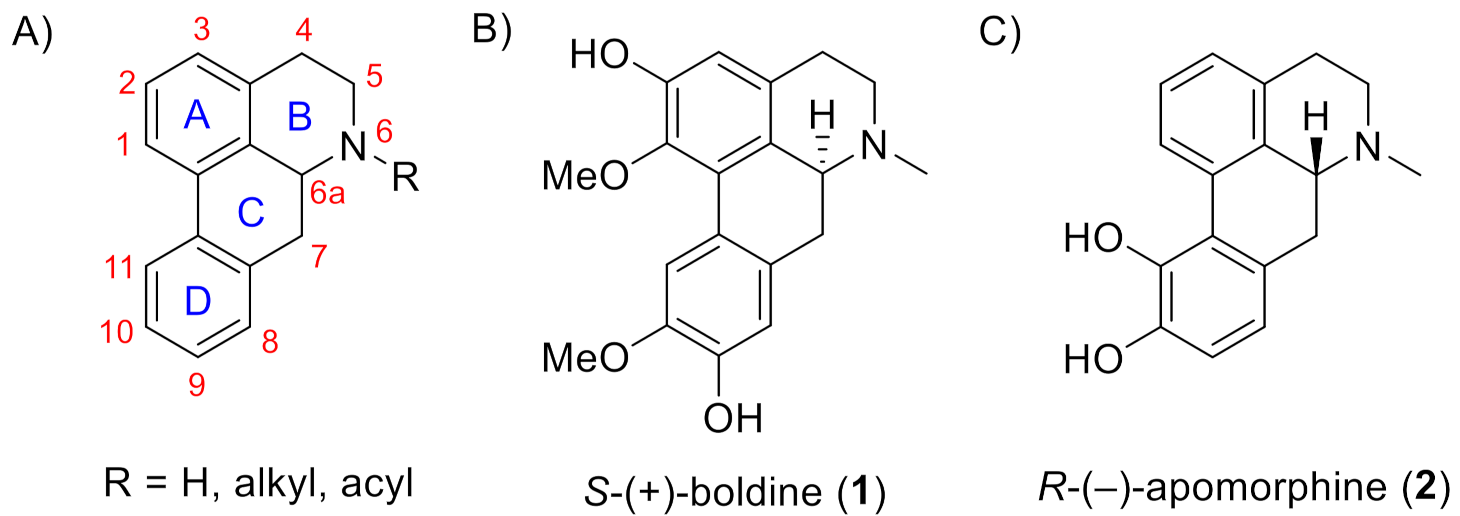

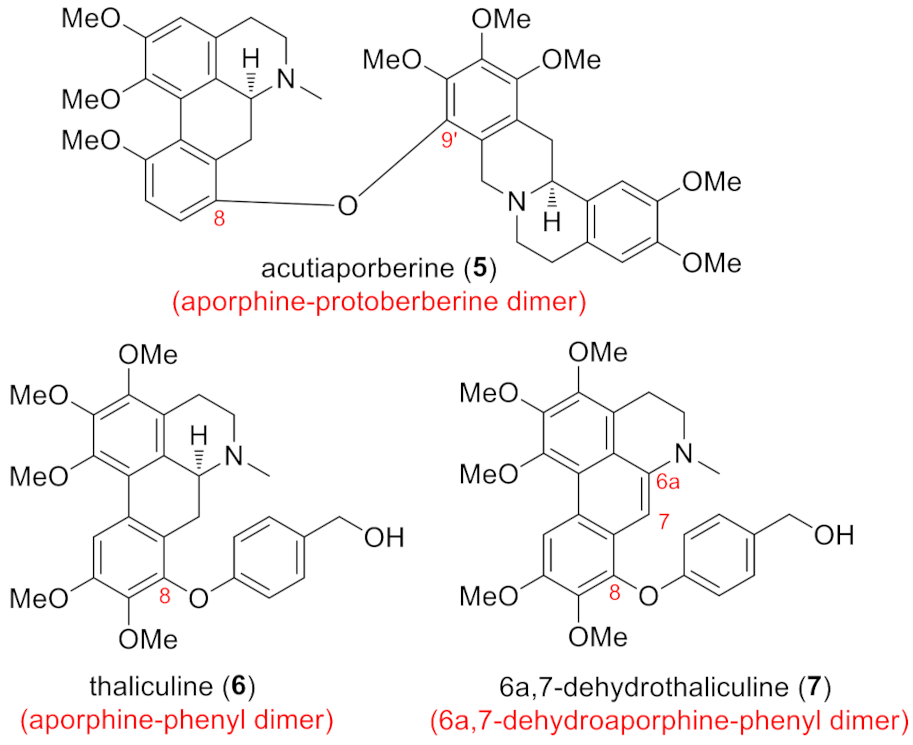
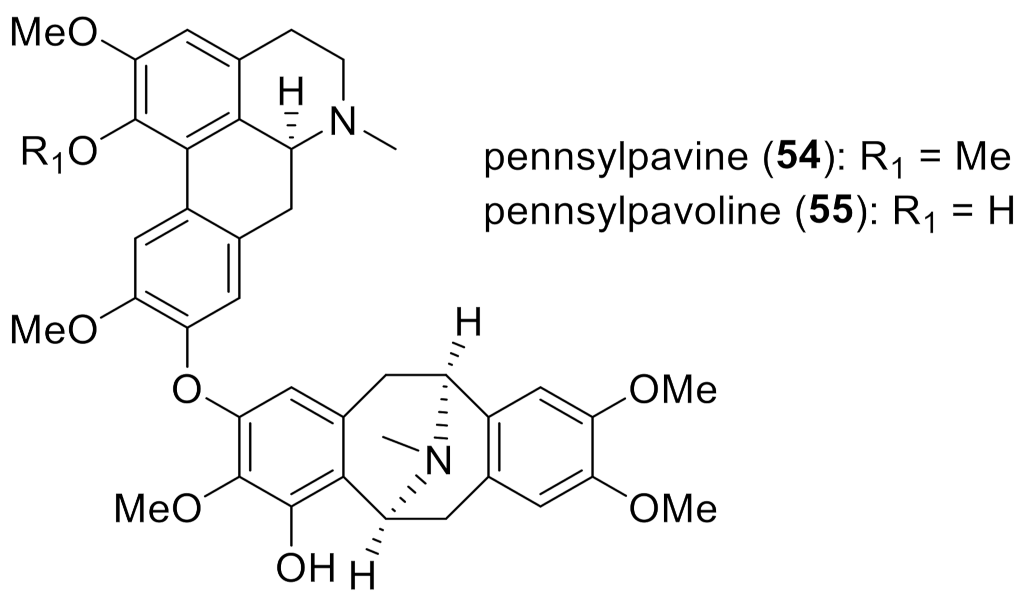

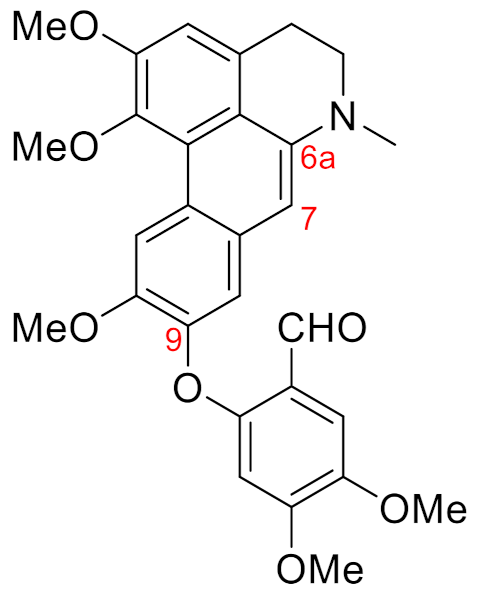
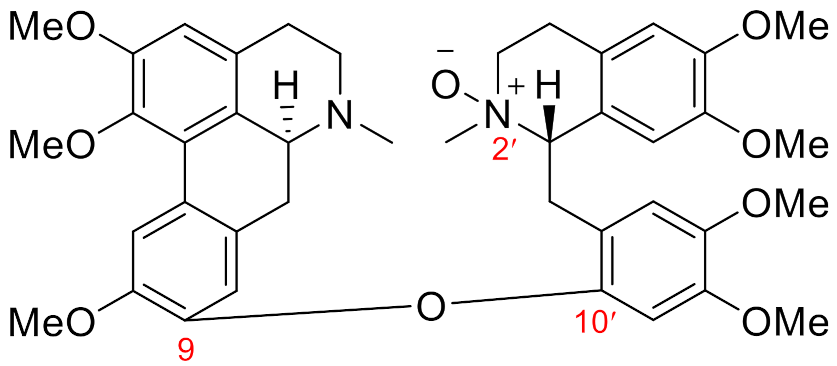
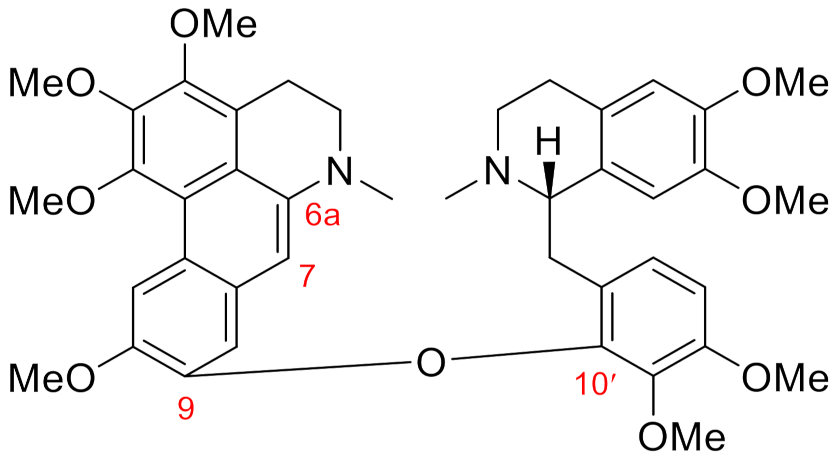
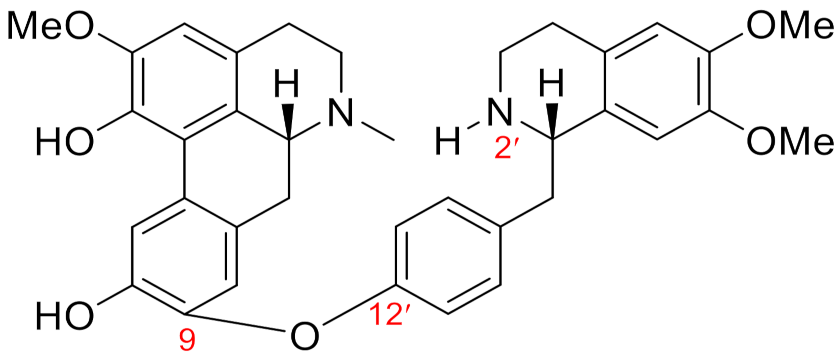
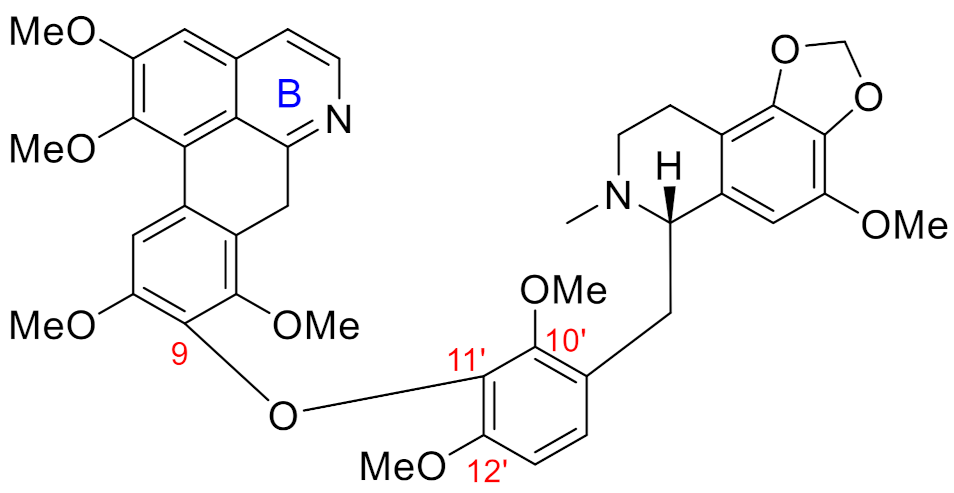
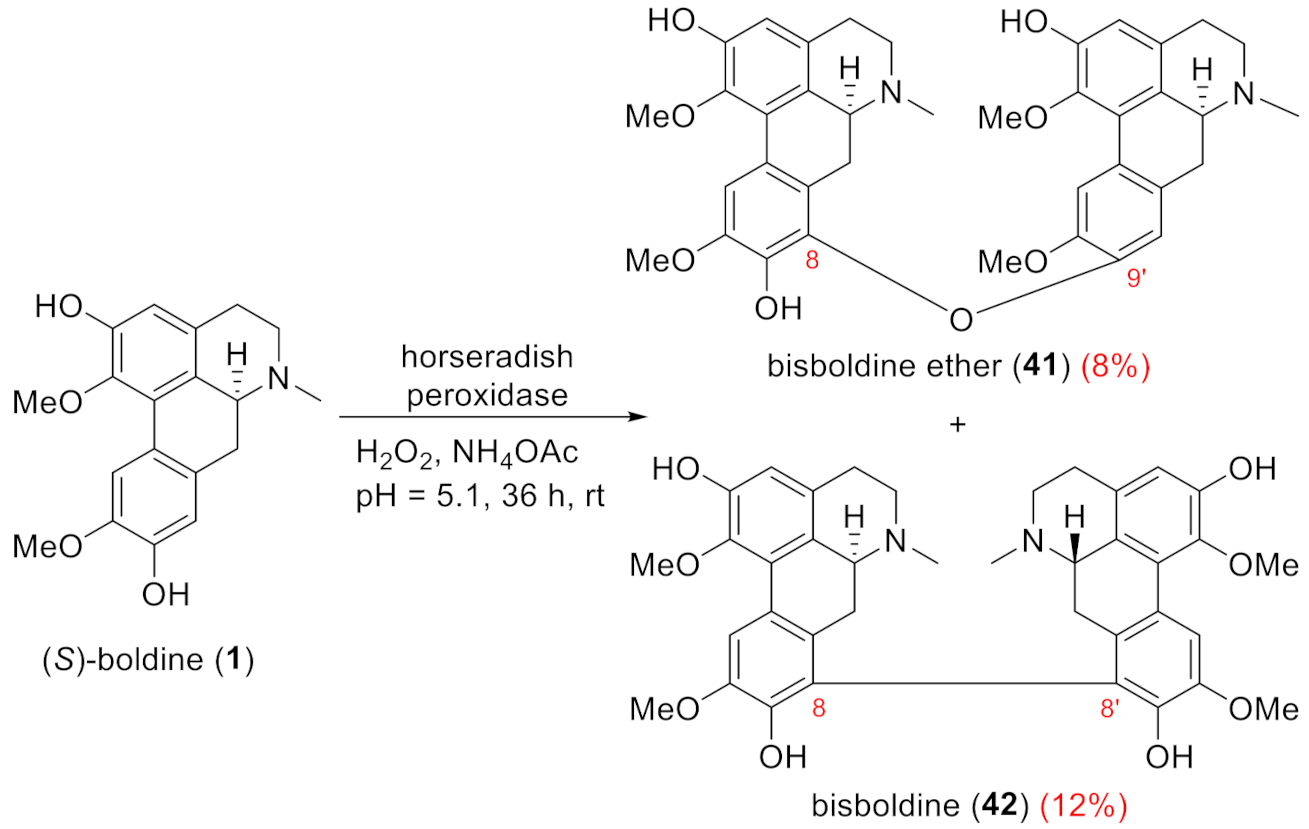
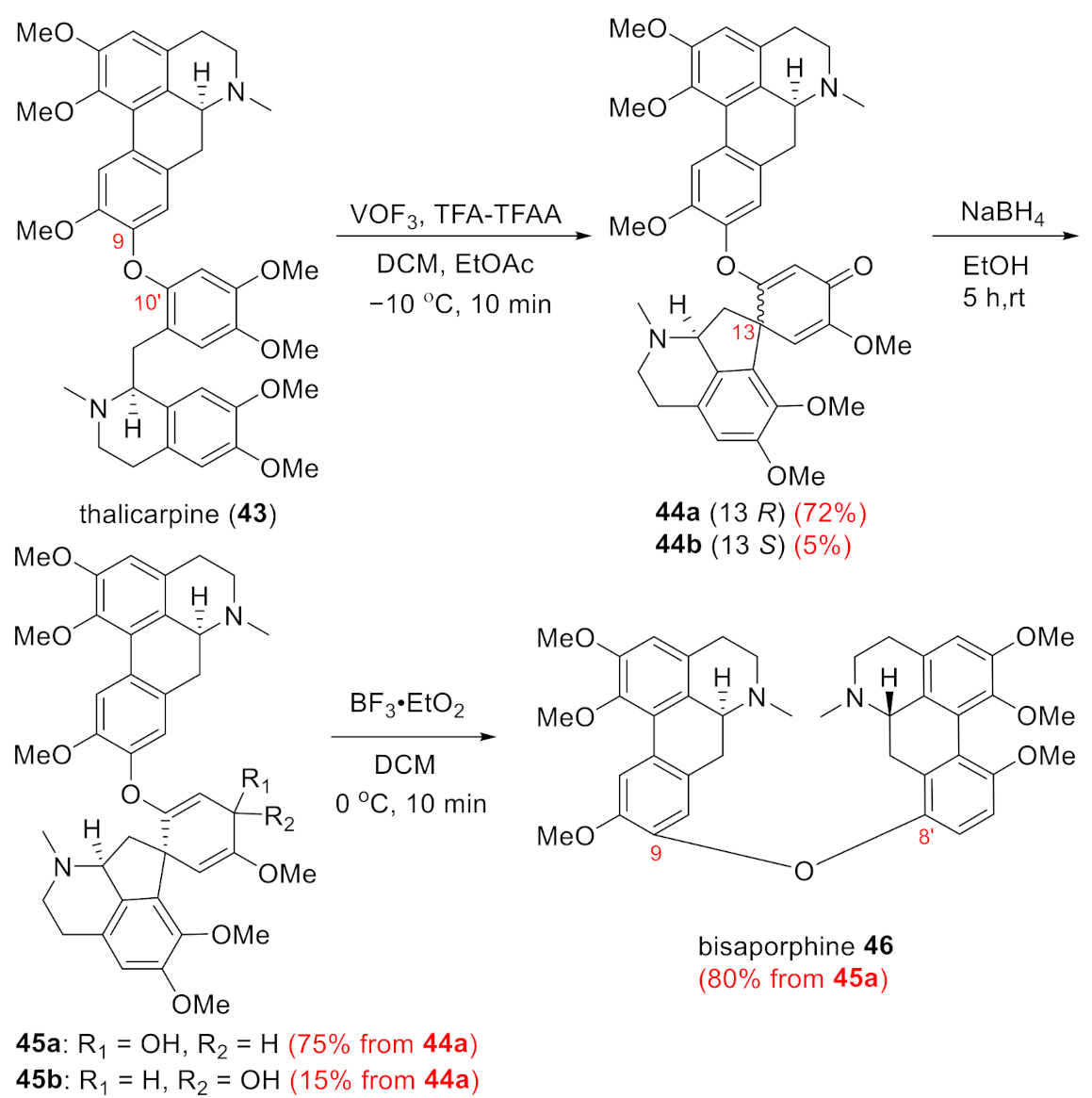
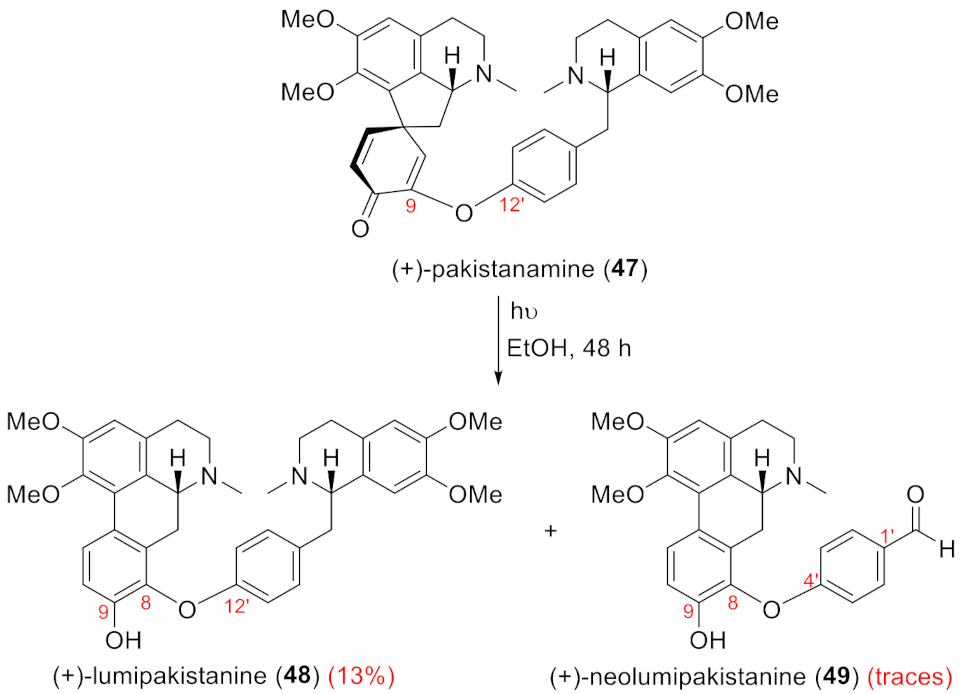
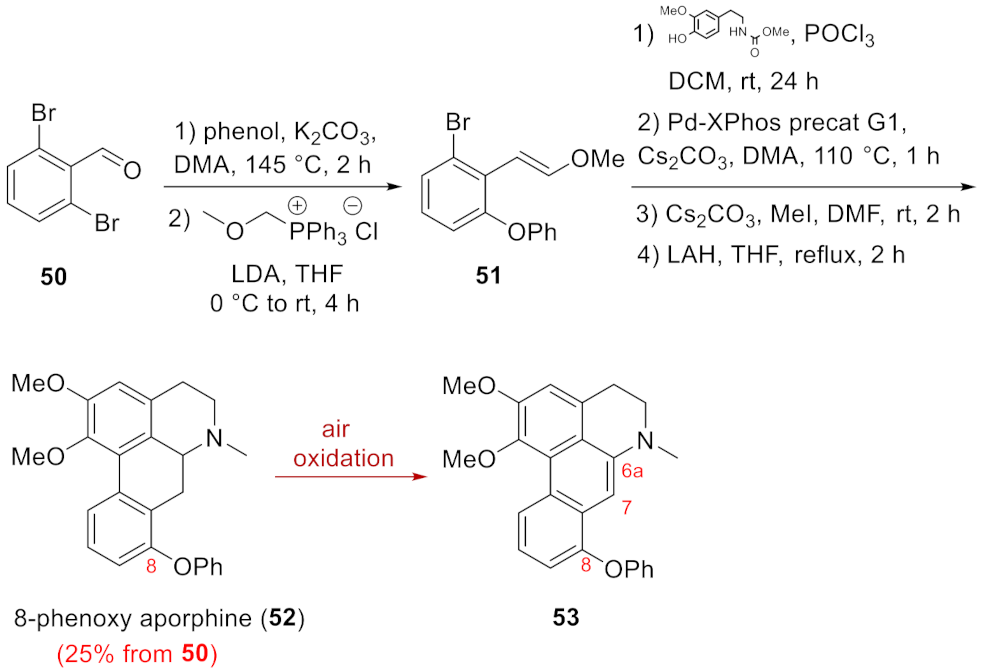


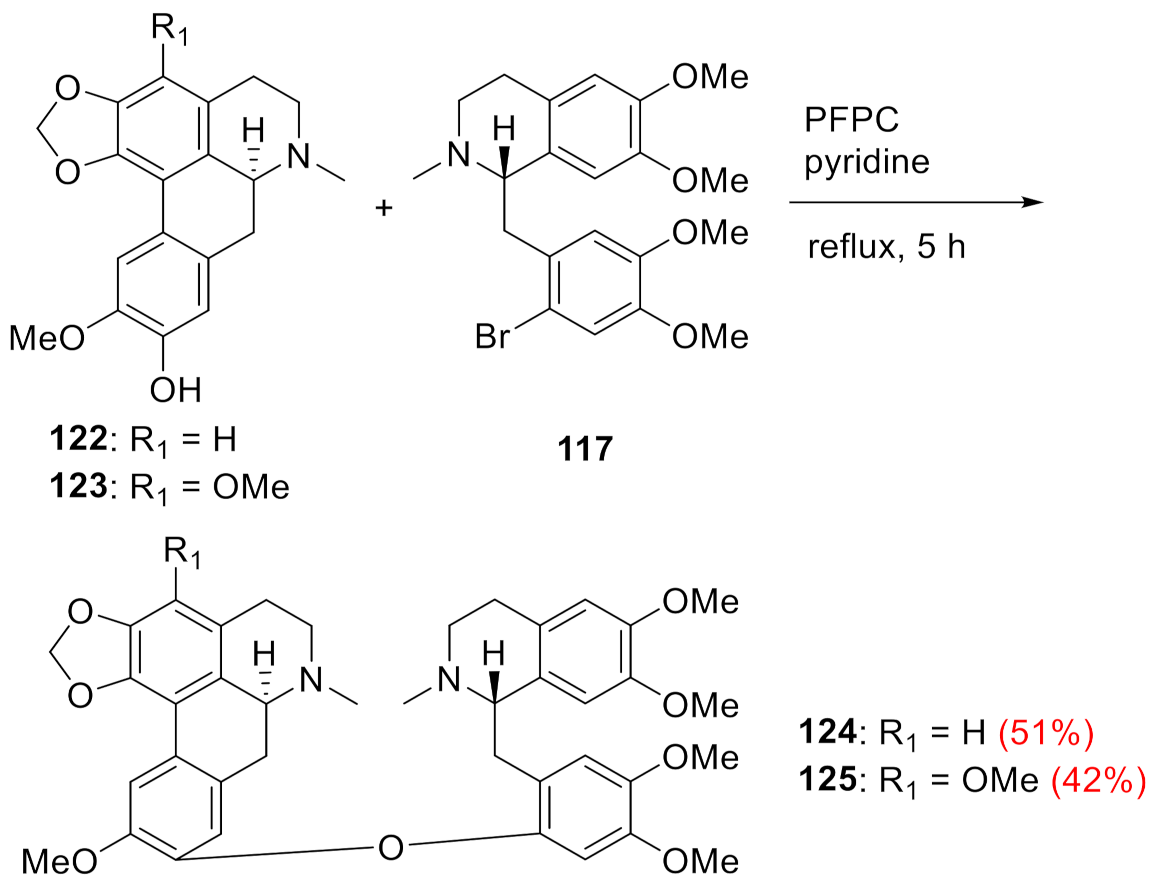
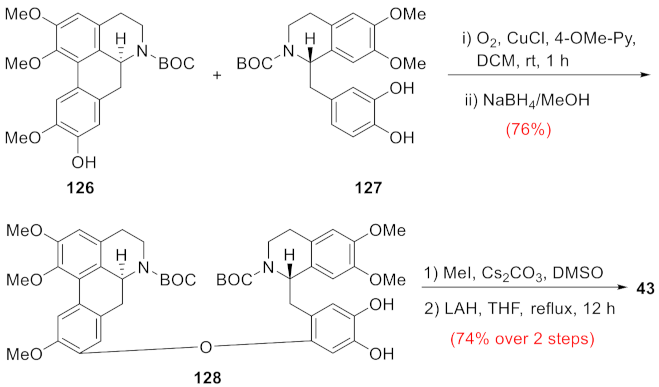
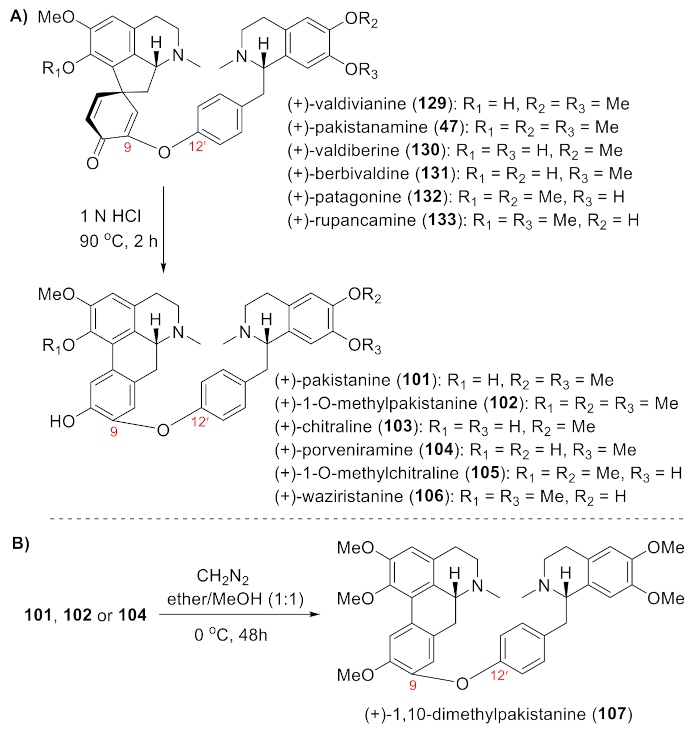
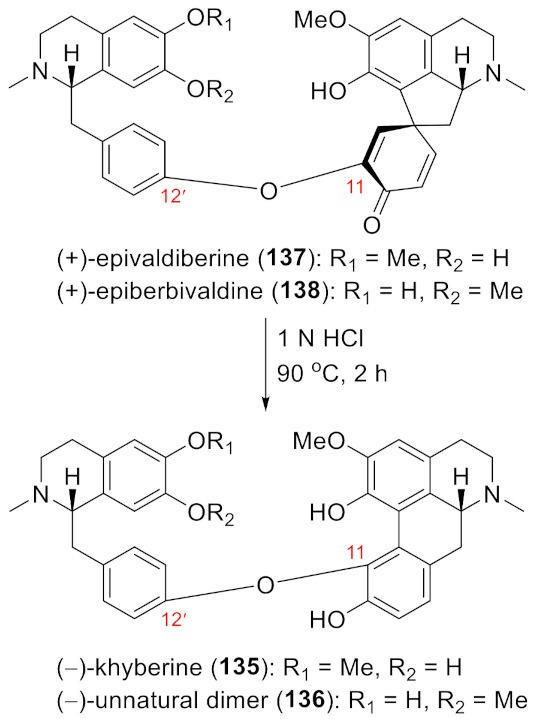
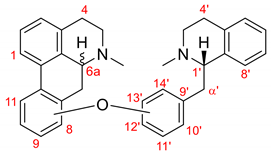
| Dimeric Types | Location of the Ether Bond | 6a |
|---|---|---|
| Thalicarpine type | C9 of the aporphine unit and C10’ of the disubstituted 12′,13′-benzylisoquinoline moiety |  |
| Fetidine type | C9 of the aporphine unit and C10’ of the disubstituted 11′,12′-benzylisoquinoline moiety |  |
| Istanbulamine type | C9 of the aporphine unit and C11’ of the monosubstituted 12′-benzylisoquinoline moiety |  |
| Thalifaberine type | C8 of the aporphine unit and C12’ of the benzylisoquinoline moiety |  |
| Pakistanine type | C9 of the aporphine unit and C12’ of the benzylisoquinoline moiety |  |
| Kalashine type | C11 of the aporphine unit and C12’ of the benzylisoquinoline moiety |  |
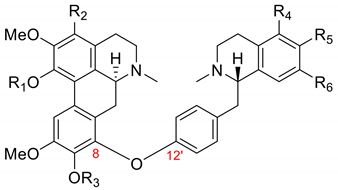
| Name | R1 | R2 | R3 | R4 | R5 | R6 | Botanical Source |
|---|---|---|---|---|---|---|---|
| (+)-thalifaberine (8) | Me | OMe | Me | H | OMe | OMe | Thalictrum faberi Ulber [30,31] Thalictrum cultratum [32,42] Thalictrum atriplex [40] |
| (+)-thalifabine (9) | Me | OMe | Me | OMe | –OCH2O– | Thalictrum faberi Ulber [30,31] | |
| (+)-thalifarapine (10) (also known as (+)-thalifaroline) | Me | OH | Me | H | OMe | OMe | Thalictrum faberi Ulber [31] Thalictrum cultratum [33,43] |
| (+)-thalifabatine (11) | Me | OMe | Me | OH | OMe | OMe | Thalictrum faberi Ulber [31] Thalictrum cultratum [42] |
| (+)-thalifasine (12) | Me | OH | Me | OH | OMe | OMe | Thalictrum faberi Ulber [31] |
| (+)-thalifaronine (13) | Me | H | Me | H | OMe | OMe | Thalictrum cultratum [32,33,42] Thalictrum faberi Ulber [38] |
| (+)-thalifaramine (14) | Me | H | Me | H | OMe | OH | Thalictrum cultratum [32,33] Thalictrum faberi Ulber [38] |
| (+)-thalifaretine (15) | Me | OMe | Me | H | OMe | OH | Thalictrum cultratum [32,33] Thalictrum artiplex [40] |
| (+)-thalifaricine (16) | Me | OMe | H | H | OMe | OH | Thalictrum cultratum [32,33] Thalictrum faberi Ulber [38] |
| (+)-thalifarazine (17) | Me | OMe | Me | H | OH | OMe | Thalictrum cultratum [32,33] Thalictrum sessile Hayata [36,37] Thalictrum faberi Ulber [38] |
| (+)-thalifalandine (18) | H | OMe | Me | H | OMe | OMe | Thalictrum faberi Ulber [34] |
| (+)-thalifaboramine (19) | Me | H | H | H | OMe | OMe | Thalictrum faberi Ulber [35] Thalictrum minus L. subsp. minus [41] |
| (+)-thalifaberidine (20) | Me | OMe | H | H | OH | OMe | Thalictrum faberi Ulber [38] |
| (+)-3-hydroxy-6′-desmethyl-9-O-methylthalifaboramine (21) | Me | OH | Me | H | OH | OMe | Thalictrum faberi Ulber [39] Thalictrum minus L. subsp. minus [41] |
| (+)-3-hydroxymethylthalifaboramine (22) | Me | OH | H | H | OMe | OMe | Thalictrum faberi Ulber [39] |
| (+)-6′-des methylthalifaboramine (23) | Me | H | H | H | OH | OMe | Thalictrum faberi Ulber [39] |
| (+)-3,5′-dihydroxy thalifaboramine (24) | Me | OH | H | OH | OMe | OMe | Thalictrum faberi Ulber [39] |
| (+)-5′-dihydroxy thalifaboramine (25) | Me | H | H | OH | OMe | OMe | Thalictrum faberi Ulber [39] |
| (+)-3-hydroxy-6′-des methylthalifaboramine (26) | Me | OH | H | H | OH | OMe | Thalictrum faberi Ulber [39] |
| (+)-thalicultratine A (27) | Me | H | Me | OH | OMe | OMe | Thalictrum cultratum [42] |
| (+)-thalicultratine B (28) | Me | OMe | Me | OMe | OMe | OMe | Thalictrum cultratum [42] |
| (+)-thalicultratine C (29) | Me | OMe | Me | –OCH2O– | OMe | Thalictrum cultratum [42] | |
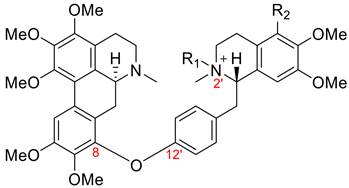
| Name | R1 | R2 | Botanical Source |
|---|---|---|---|
| (+)-thalicultratine H (30) | αO | OMe | Thalictrum cultratum [42] |
| (+)-thalicultratine I (31) | βO | OMe | Thalictrum cultratum [42] |
| (+)-thalicultratine J (32) | αO | OH | Thalictrum cultratum [42] |
| (+)-thalicultratine K (33) | βO | OH | Thalictrum cultratum [42] |

| Name | R1 | R2 | R3 | Botanical Source |
|---|---|---|---|---|
| (+)-thalicultratine D (34) | H | H | OMe | Thalictrum cultratum [42] |
| (+)-thalicultratine E (35) | OMe | OH | OMe | Thalictrum cultratum [42] |
| (+)-thalicultratine F (36) | OMe | OMe | OMe | Thalictrum cultratum [42] |
| (+)-thalicultratine G (37) | OMe | –OCH2O– | Thalictrum cultratum [42] | |
| (+)-dehydrothalifaberine (38) | OMe | H | OMe | Thalictrum faberi Ulber [31] Thalictrum artiplex [40] Thalictrum cultratum [42] |
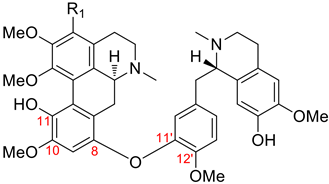
| Name | R1 | Botanical Source |
|---|---|---|
| (+)-faurithaline (39) | H | Thalictrum fauriei [43] |
| (+)-3-methoxyfaurithaline (40) | OMe | Thalictrum fauriei [43] |

| Name | 6a | R1 | R2 | R3 | R4 | R5 | R6 | Botanical Source |
|---|---|---|---|---|---|---|---|---|
| (+)-hernandaline (60) |  | Me | H | Me | CHO | OMe | OMe | Hernandia ovigera L. [55] Hernandia nymphaeifolia [56,57] |
| (+)-thaliadine (61) |  | Me | OMe | Me | CHO | OMe | OMe | Thalictrum minus race B [58] Thalictrum minus L. ssp. Majus [59] Thalictrum elegans [60] |
| (−)-natalinine (62) |  | H | H | H | H | CHO | H | Berberis empetrifolia [61] |
| (−)-natalamine (63) |  | H | H | H | H | CH2OH | H | Berberis empetrifolia Lam. [62] |
| (−)-6aR-2′-methoxy carbonyl-thaliadine (64) |  | Me | OMe | Me | CO2Me | OMe | OMe | Thalictrum cirrhosum Levl. [63] |
| (−)-6aR-2′-carboxyl -thaliadine (65) |  | Me | OMe | Me | COOH | OMe | OMe | Thalictrum cirrhosum Levl. [63] |
| (−)-6aR-3-methoxy- hernandalinol (66) |  | Me | OMe | Me | CH2OH | OMe | OMe | Thalictrum cirrhosum Levl. [63] |
Publisher’s Note: MDPI stays neutral with regard to jurisdictional claims in published maps and institutional affiliations. |
© 2021 by the authors. Licensee MDPI, Basel, Switzerland. This article is an open access article distributed under the terms and conditions of the Creative Commons Attribution (CC BY) license (https://creativecommons.org/licenses/by/4.0/).
Share and Cite
Ali, G.; Cuny, G.D. 8-, 9-, and 11-Aryloxy Dimeric Aporphines and Their Pharmacological Activities. Molecules 2021, 26, 4521. https://doi.org/10.3390/molecules26154521
Ali G, Cuny GD. 8-, 9-, and 11-Aryloxy Dimeric Aporphines and Their Pharmacological Activities. Molecules. 2021; 26(15):4521. https://doi.org/10.3390/molecules26154521
Chicago/Turabian StyleAli, Ghada, and Gregory D. Cuny. 2021. "8-, 9-, and 11-Aryloxy Dimeric Aporphines and Their Pharmacological Activities" Molecules 26, no. 15: 4521. https://doi.org/10.3390/molecules26154521
APA StyleAli, G., & Cuny, G. D. (2021). 8-, 9-, and 11-Aryloxy Dimeric Aporphines and Their Pharmacological Activities. Molecules, 26(15), 4521. https://doi.org/10.3390/molecules26154521






